蛇绿岩作为古大洋岩石圈或古洋壳残余,是恢复古大洋、识别古板块缝合带的最直接证据(Coleman, 1977; 肖序常和王方国, 1984; 张旗和肖序常, 1995; Dilek and Furnes, 2011)。通过对这类岩石的岩石学、矿物学、地球化学和年代学等的研究,对反演古板块俯冲消减、壳幔相互作用、古缝合的识别及古板块重建等均具有重要的科学意义(张旗和肖序常, 1995; Dilek and Furnes, 2011)。更为重要的是蛇绿岩与铬铁矿等国家急需的矿产的形成密切相关,通过对蛇绿岩的研究,可以指导寻找有关矿产,对解决国家能源需求十分必要(Dickey, 1975)。近年来,随着对地球的早期形成演化、哥伦比亚以及罗迪尼亚等超大陆的裂解与聚合等研究,进一步拓展了蛇绿岩的研究领域(Zhao et al., 2002, 2004)。前寒武纪蛇绿岩的研究,对探讨行星地球的早期形成、演化,板块构造的起源,洋-陆分布特征,前寒武纪超大陆的裂解与聚合,古地温梯度以及“雪球化地球”模式等重大地质问题具有重要的意义(Zhao et al., 2002, 2004; Rogers and Santosh, 2003; Li et al., 2008)。
前人已经对显生宙蛇绿岩进行了长期深入的研究,有许多论述和专著问世,对古特提斯洋和古亚洲洋的形成和演化、青藏高原的形成过程和机制等关键科学问题提供了重要约束(Yin and Harrison, 2000; Li et al., 2013)。但是,对前寒武纪蛇绿岩(例如元古代蛇绿岩)的研究相对较少。本文主要总结了国外典型元古代蛇绿岩和伴生的铬铁矿的分布、野外产出及岩石学特征,包括两部分:一是早元古代蛇绿岩及铬铁矿,以芬兰的Outokumpu-Jormua蛇绿岩(ca.1.97~1.96Ga)和加拿大Purtuniq蛇绿岩(~1998Ma)为代表;二是中-新元古代蛇绿岩及铬铁矿,以埃及东部沙漠区蛇绿岩(~750Ma)和北非东部蛇绿岩(ca.900~800Ma)为代表。本文预阐明:(1)世界有哪些元古代蛇绿岩,其特点如何,与显生宙蛇绿岩有哪些异同点;(2)元古代蛇绿岩中有无铬铁矿,它们属岩浆成因、抑或是地幔熔融残余成因。
1 早元古代蛇绿岩及铬铁矿 1.1 芬兰早元古代蛇绿岩和铬铁矿芬兰早元古代蛇绿岩地处Fennoscandian地盾东北缘的Svecokarelian的褶皱带边缘,构成一条不连续的、长达200km的蛇绿岩带,包含1.97Ga的Outokumpu蛇绿岩和1.96Ga的Jormua蛇绿岩。在Svecokarelian构造运动时,这些蛇绿岩侵位于元古代Kalevian浊积片岩带中(Koistinen, 1981),随后经历了区域范围的褶皱、逆冲和剪切(Koistinen, 1981; Ward and Kohonen, 1989)。浊积岩代表裂谷海相沉积(Ward, 1987),其中含有1.92Ga的碎屑锆石(Claesson et al., 1993)。该带的两个蛇绿岩均被1.97~1.95Ga的辉长岩及镁铁质岩墙(含太古代锆石捕虏晶)所穿切(Peltonen et al., 1998, 2003; Säntti et al., 2006)。Outokumpu蛇绿岩的豆荚状铬铁矿区(Vasarakangas)附近的Horamanaho变辉长岩锆石年龄为1.97Ga(Huhma, 1986; Vuollo et al., 1995)。Jormua蛇绿岩的变玄武岩中锆石的U-Pb年龄为1960±12Ma和1953±2Ma(Kontinen, 1987);切割地幔橄榄岩的辉长岩岩墙的锆石年龄为1953±2Ma(Peltonen et al., 1996)。
1.1.1 Outokumpu蛇绿岩 1.1.1.1 野外产状Outokumpu蛇绿岩位于该带南端的Karelian片岩带中,蛇绿岩岩片分布范围较大,变质较深,由众多的透镜状蛇纹岩碎块构成,覆盖面积约5000km2。这些超镁铁岩透镜体(长几千米,厚几百米)由蛇纹岩±滑石碳酸盐组成(图 1)。该蛇绿岩组合齐全,由地幔橄榄岩(纯橄岩、方辉橄榄岩和二辉橄榄岩)、不完整的壳层组合(纯橄岩、异剥橄榄岩、辉石岩、辉长岩)、岩墙和镁铁质火山岩组成,部分镁铁质岩石变质已达角闪岩相(Kontinen, 1987; Liipo et al., 1995; Säntti et al., 2006)。
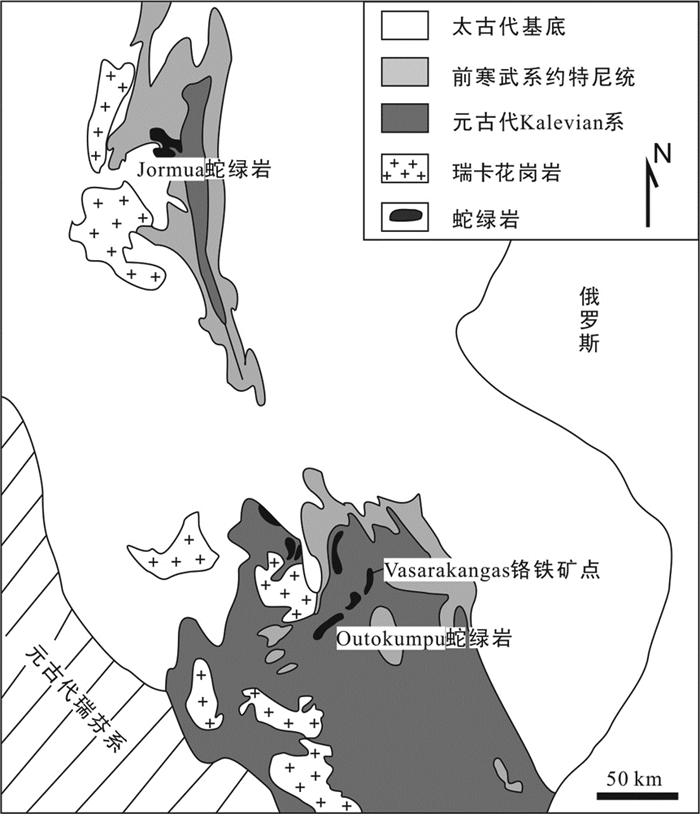
|
图 1 芬兰Outokumpu-Jormua蛇绿岩带地质简图(据Vuollo et al., 1995) Fig. 1 Geological sketch map of the Outokumpu-Jormua ophiolite in Finland (after Vuollo et al., 1995) |
地幔岩全蛇纹石化(±皂石化),蛇纹岩中仍可见网环结构和绢石,但粗大的橄榄石缺失波状消光、粗粒的斜方辉石缺失单辉的出溶条纹等塑性变形。这些特征表明地幔橄榄岩经历了高温重结晶,具斑状变晶结构,且矿物均以高MgO为特征:Ol(橄榄石)残晶(Fo=92~94)、Opx(斜方辉石)残晶(En=93~94,Fs=6~7),Cpx(单斜辉石)残晶(En=70~74,Wo=22~24,Fs=3~4),粒间铬尖晶石显示叶理(Cr#=0.75~0.98,Mg#=0.1~0.4)(Säntti et al., 2006)。除上述高铬的重结晶铬尖晶石之外,尚见有变形虫状的、Cr#为0.41~0.67的残余铬尖晶石,与亏损地幔橄榄岩中的铬尖晶石相符合。此外,地幔橄榄岩亏损不相容元素、具U型REE(稀土元素)配分型式(Vuollo and Piirainen, 1989)。
Outokumpu蛇绿岩上覆的堆晶岩层序不完整,厚约1~3km,由纯橄岩、异剥橄榄岩、辉石岩、辉长岩及镁铁质火山岩组成。纯橄岩已全蛇纹石化,但是其中橄榄石残晶(Fo=84~92)及铬尖晶石(Cr#=0.65,Mg#=0.65~0.4)以低Mg、低Cr而区别于地幔橄榄岩中者。部分异剥橄榄岩可见嵌晶结构。岩墙已变质,致使席状岩墙特征难于识别,但其高Mg、Cr、Ni和低TiO2、Zr的特点似应来自玻安质岩浆(Vuollo, 1994)。
虽然对Outokumpu蛇绿岩的成因有不同的解释,但主体认为其为肢解的大洋岩石圈残片。其中的岩墙和火山岩的化学成分近似于岛弧环境的洋壳,地幔橄榄岩中赋存的高Cr铬铁矿可与近代产于俯冲带的地幔橄榄岩(方辉橄榄岩+少量纯橄岩)相对应,加之岩墙和火山岩的玻安质属性,可厘定其为俯冲带型蛇绿岩(Kontinen, 1987; Vuollo, 1994; Liipo et al., 1995; Vuollo et al., 1995)。
1.1.1.3 成矿特征在Outokumpu蛇绿岩包含铬铁矿以及含铬的矿物(铬透辉石、铬透闪石、铬金云母等)(Von Knorring et al., 1986)。铬铁矿床可以分为两类。一类是产于堆晶岩(辉长岩)底部近岩石莫霍面的堆晶铬铁矿,属高铝型铬铁矿,其174个全岩样品的地球化学特征(Cr2O3=44.04%,Al2O3=18.93%,TiO2=0.13%)完全可与典型堆晶铬铁矿(Cr2O3=45.08%,Al2O3=19.97%,TiO2=0.05%,Cr#=0.42~0.64,Mg#=0.21~0.42)相对比,指示其为岩浆分异作用的产物(Vuollo et al., 1995)。另一类是产于地幔岩中的豆荚状铬铁矿,属高铬型铬铁矿。该铬铁矿是近年来Vuollo et al. (1995)在奥托昆普城(Outokumpu)东北约20km的滑石采石场发现的,故其具体产出部位不详。Vuollo et al. (1995)称之为Vasarakangas铬铁矿,野外与变蛇纹岩和滑石碳酸盐岩伴生,具结核状和块状结构特征。该铬铁矿的成分变化较宽(Cr2O3=52.2%~63.4%,Al2O3=2.10%~10.3%,TiO2 < 0.03%,Cr#=0.59~0.60,Mg#=0.56~0.65)(Liipo et al., 1995; Vuollo et al., 1995),可与近代俯冲带方辉橄榄岩中高Cr的铬铁矿相比(Roberts, 1988)。结合地幔岩中纯橄岩的出现,这些高铬型铬铁矿指示Outokumpu蛇绿岩源区的高度局熔。两种类型铬铁矿的铬尖晶石均与豆荚状铬铁矿成分相近,而区别于层状铬铁矿(Vuollo and Piirainen, 1989)。铬铁矿中未见原生的硅酸盐,仅在块状矿石裂隙中见填间的绿泥石(含Cr2O3达6.4%)、碳酸盐、辉砷镍矿和红砷镍矿。值得注意的是,该铬铁矿以富集IPGE(Os-Ir-Ru;铱族元素)、亏损PPGE(Rh-Pt-Pd;钯族元素)为特征,与显生宙蛇绿岩中的铬铁矿极为相似(Vuollo et al., 1995),从而也提供了元古代存在板块构造的重要证据。
Outokumpu蛇绿岩中也赋存Cu-Co-Zn-Au(铜-钴-锌-金)矿,矿脉垂直状切穿堆晶岩层理,故为交代作用的产物。可见辉砷镍矿和红砷镍矿作为半自形和他形颗粒产于高铁铬铁矿中,或作为自形颗粒产于次生硅酸盐中。大量Cu-Co-Zn-Au矿石的出现而诱发的交代作用,致使岩带及铬铁矿中常含有较高的锌(Zn=0.11%~0.18%),铬铁矿中ZnO的含量随蚀变而增加,在皂石中可高达4.8%,故区别于中生代铬铁矿(Liipo et al., 1995; Vuollo et al., 1995)。
1.1.2 Jormua蛇绿岩 1.1.2.1 野外产状Jormua蛇绿岩保存相对完好,位于芬兰最北部的Karnuu片岩带中央、早元古代Svecokarelides地盾的东缘,逆冲于Karelian克拉通边缘之上(图 1、图 2)。在早元古代Svecokarelian造山期,蛇绿岩被肢解成3个(东部,中部和西部)岩块,并发生低角闪岩相变质。蛇绿岩面积较大,被断裂所包围,面积约5×20km2,由蛇纹石化地幔橄榄岩、E-MORB(富集型洋中脊)席状岩墙和枕状玄武岩组成,其形成与Karelian克拉通的裂解(1.97~1.95Ga)有关(Kontinen, 1987; Peltonen et al., 1998)。
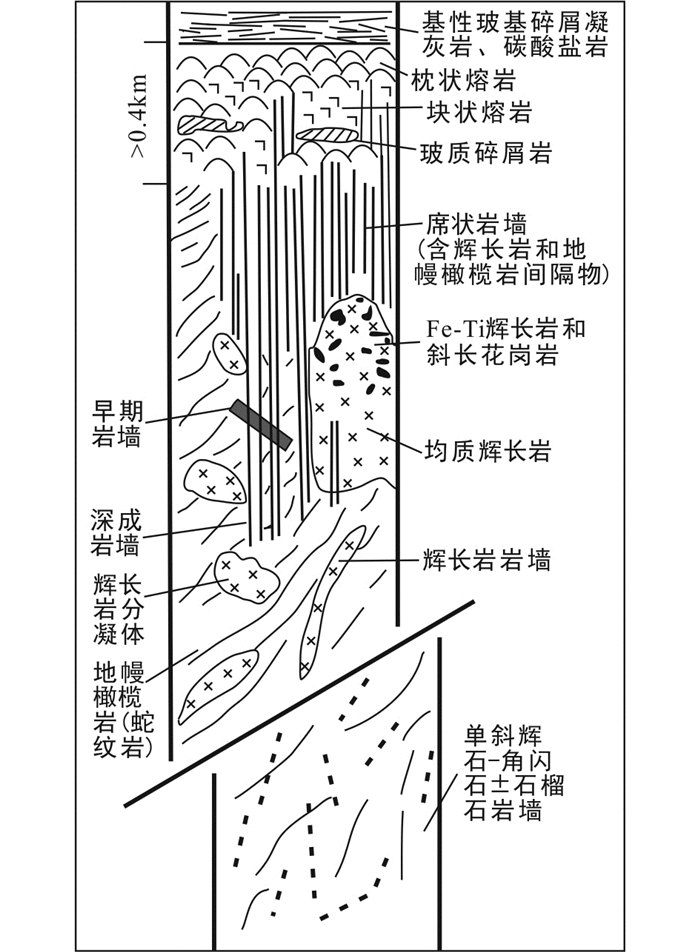
|
图 2 重建的芬兰Jormua蛇绿岩柱状图(据Peltonen et al., 1996) Fig. 2 Reconstructed column-section of the Jormua ophiolite in Finland (after Peltonen et al., 1996) |
蛇绿岩基底为蛇纹岩,镜下多见网环结构,由叶蛇纹石、镍硫化物和滑石碳酸盐组成。蛇绿岩层序的壳层较薄(100~400m),缺失层状镁铁-超镁铁堆晶岩,而代之以辉长岩岩株。地壳下岩浆房的缺失可能与慢速扩张脊区域相对较厚的轴部岩石圈有关(Peltonen and Kontinen, 2004)。辉长岩岩株之上为镁铁质岩墙及和玄武质枕状熔岩。镁铁质岩墙为半平行的变质辉绿岩,发育冷凝边。辉长岩沿着半垂直的管道作为岩墙和小岩株侵入于蛇纹岩中,或作为岩墙中的间隔物,并且在辉长岩中可见浅色英云闪长岩和奥长花岗岩脉体(Kontinen, 1987)。Jormua蛇绿岩中岩墙很发育,厚度达1km以上,单个岩墙20~120cm宽,最大宽度为6m,具冷凝边,岩墙之间有辉长岩的间隔物,构成岩墙群。值得注意的是,岩墙具有时代和成分的差异,如厚的变质辉绿岩岩墙被薄的粒玄岩质岩墙所侵入,也有的岩墙被包裹于橄榄岩中——称为‘deep dyke’,它们既可作为单个岩墙,也可呈复合岩墙(dyke in dyke)。西部的地幔橄榄岩(蛇纹岩)岩块被由单斜辉石+角闪石+石榴石组成的岩墙所侵入,该岩墙可能代表古老岩石圈地幔的碎片。此外,根据岩墙的穿插关系、成分及风化表面具有红色赤铁矿斑点等特点尚可辨认出4种岩墙,它们的侵位早于岩墙群单元(‘main basalt suite’ dyke),被称为‘early dyke’(Peltonen et al., 1996)。最顶部喷出岩由枕状熔岩、枕状角砾岩和玻质碎屑岩组成,其中玻质碎屑岩示浅水环境。部分地区可见喷出岩直接覆盖于地幔橄榄岩之上(Peltonen et al., 1996)。
1.1.2.2 岩石地球化学特征蛇纹岩富Cr(>2000×10-6)和Ni(>1000×10-6),与显生宙亏损地幔橄榄岩类似(橄榄石的Fo=82~87,透辉石为En=50、Wo=50)。蛇纹岩较低的MgO/SiO2比值(< 1.15)和Al2O3含量(1.33%~2.51%),提示了它们应相当于方辉橄榄岩,其REE有2种配分型式:大多为平坦型,近似于E-MORB;少量为U型,指示其有玄武质流体的影响(Peltonen and Kontinen, 2004)。
辉长岩岩株包括镁质辉长岩和铁质辉长岩,后者(Fe2O3>17%,TiO2>5%)以含钛铁矿为特征,均显示拉斑系列分异趋势,两者为过渡关系。鉴于辉长岩的Ti、Zr、Cr、Ni均低于熔岩和岩墙,其母岩浆的演化程度应当较高,与熔岩和岩墙成因不同。奥长花岗岩脉体高Na2O、低K2O、高REE丰度、高Zr-Y含量(Zr>600×10-6,Y>100×10-6)以及Eu负异常,类似于洋中脊花岗岩和高Ti蛇绿岩中的花岗岩。浅色英云闪长岩的锆石U-Pb年龄为1954±12Ma,Nd同位素模式年龄为1950Ma,接近于熔岩和岩墙的平均年龄(1950Ma; Peltonen and Kontinen, 2004),指示其有成因联系。
Jormua蛇绿岩中的变玄武岩和变质辉绿岩岩墙为亚碱性,低K2O和TiO2,具深海拉斑玄武岩属性,SiO2=44.3%~53.46%,MgO=5.30%~10.79%,TiO2=0.82%~1.35%,Mg#=61.1~70.7。REE配分型式不同于典型MORB(洋中脊玄武岩),而属于LREE(轻稀土元素)略富集的过渡型E-MORB(Saunders, 1984)。微量元素特征显示基性岩均为洋底玄武岩,较高的Cr(600×10-6)、Ni(300×10-6)含量可能代表了未被改造的地幔熔体(Kontinen, 1987)。
1.1.2.3 成矿特征铬铁矿仅见于东部岩块滑石碳酸盐化的地幔橄榄岩(Pitkänperä区)中,仅有2个矿体长度在1m以上,最大者为0.8×5m2。铬尖晶石的Cr#=~0.55、Mg#=~0.76、TiO2=~0.24%,铬尖晶石常有铁铬铁矿和铬磁铁矿的蚀变边。Jormua蛇绿岩的铬铁矿以较高的TiO2含量区别于Outokumpu蛇绿岩中的低TiO2铬铁矿(< 0.03%)(Peltonen et al., 1998; Tsuru et al., 2000; Säntti et al., 2006)。值得注意的是,铬铁矿中可见钠角闪石包体,其初始γOs值(+8±0.5和+3.0±0.1;t=~1.95Ga),符合MORB型大洋地幔的特征(Tsuru et al., 2000)。
1.1.3 小结综上可知,Jormua杂岩大量的蛇纹岩应形成于裂谷区的拉张裂隙或减薄的大陆壳。当太古代克拉通在~1.95Ga开始大陆裂解时,首先形成了OIB型的‘early dykes’,它们在最上部岩石圈拉伸的初始阶段侵位,并伴随有限的、短暂的扩张,随即在汇聚的边缘形成了E-MORB型玄武质洋壳,反映了存在两个不同的地幔源区(Peltonen et al., 1996; Peltonen and Kontinen, 2004)。
根据Outokumpu-Jormua蛇绿岩的岩石组合、残余矿物学特征、两种成因chromite的出现,不难看出:早元古代的Outokumpu-Jormua蛇绿岩完全可与中生代蛇绿岩相对比,区别是该带铬铁矿受蚀变作用影响,当MgO下降时引起Zn的增加,从而区别于中生代蛇绿岩(Augé, 1987; Jan and Windley, 1990; Yang and Seccombe, 1993)。Outokumpu和Jormua蛇绿岩带,可看作是Fennoscandian地盾东北Svekokarilian褶皱带边缘的一条缝合带,增生到了克拉通边缘(Koistinen, 1981; Park, 1984)。两个蛇绿岩形成于不同的构造环境,Outokumpu蛇绿岩和铬铁矿形成于俯冲带环境,而Jormua蛇绿岩则形成于过渡的洋中脊环境。因此,Outokumpu-Jormua蛇绿岩为元古代板块构造提供了依据。
1.2 加拿大早元古代蛇绿岩 1.2.1 野外产状加拿大早元古代蛇绿岩系指Purtuniq蛇绿岩,位于加拿大地盾魁北克构造省北缘的Cape Smith Belt(CSB)带中,1860~1930Ma弧-陆碰撞事件致使其逆冲于Superior构造省的太古代英云闪长片麻岩之上(Hoffman, 1985; St-Onge and Lucas, 1990; Machado et al., 1993)(图 3)。Purtuniq蛇绿岩经历了3期构造变形,部分岩石可达高绿片岩相-低角闪岩相(Bégin, 1989)。蛇绿岩主要由底部的层状镁铁-超镁铁岩和镁铁质席状岩墙杂岩、上部的枕状和块状镁铁质火山岩以及稀少的斜长花岗岩岩床和岩墙组成,未见亏损的地幔岩(图 4)。席状岩墙出露范围为700×400m2,单个岩墙宽从20cm至60cm,具冷凝边。从席状岩墙杂岩至连续的枕状熔岩经过~300m宽的过渡带(Scott et al., 1991)。斜长花岗岩罕见,仅在火山岩中呈岩床(宽 < 5m)产出。Purtuniq蛇绿岩的综合剖面厚度大于9km(St-Onge et al., 1989; Scott et al., 1992),蛇绿岩被肢解、逆冲和褶皱,其原始厚度可能更大(ca.10~12km),明显大于显生宙洋壳的厚度。
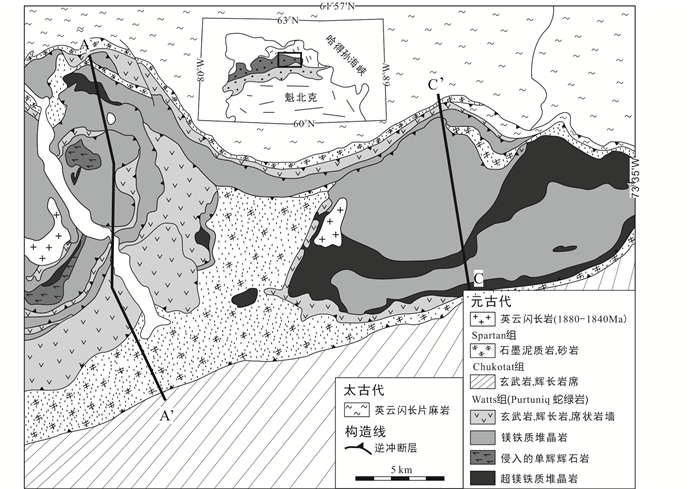
|
图 3 加拿大魁北克Cape Smith带Purtuniq蛇绿岩东部地质简图(据Scott et al., 1992简化) Fig. 3 Geological sketch map of the eastern portion of the Purtuniq ophiolite, Cape Smith Belt, northern Quebec, Canada (simplified after Scott et al., 1992) |

|
图 4 据Purtuniq蛇绿岩横剖面重建的Watts组和Spartan组的综合洋壳剖面(据Scott et al., 1991文中A-A’和C-C’剖面重建) Fig. 4 Resconstructed composite ophiolite section of Watts Formation and Spartan Formation of the Purtuniq ophiolite (the segments 1-4 are indicated on sections A-A' and C-C' after Scott et al., 1991) |
Purtuniq蛇绿岩中的火山岩及岩墙均为拉斑玄武系列,未见中酸性火山岩,堆晶岩中未见Opx(斜方辉石)出现,且斜长花岗岩少见,故与岛弧环境蛇绿岩的特征相驳(Pearce et al., 1984; Saunders et al., 1980)。依据地球化学资料,可以将Purtuniq蛇绿岩划分为两套不同的拉斑玄武质洋壳(Scott et al., 1991, 1999)。较老的一套由熔岩(枕状熔岩、块状火山岩)、镁铁质席状岩墙和以层状辉长岩为主的堆晶岩组成,为拉斑玄武质,具扁平的REE配分型式,近似于MORB;席状岩墙εNd(2.0Ga)=+4.0~+5.3,代表洋中脊环境下形成的岩石组合(MORB型);在成分和岩相学上近似于近代大洋扩张脊形成的洋壳(Scott et al., 1992),Sm-Nd同位素也支持了其大洋成因(Hegner and Bevier, 1989),其中2个层状辉长岩的定年结果为1998Ma和2000~1995Ma(Parrish, 1989)。较年轻的一套由镁铁质席状岩墙和层状镁铁-超镁铁堆晶岩组成,为拉斑玄武质岩石,其中的岩墙富集LREE和大离子亲石元素(LILE),具有较低的εNd(2.0Ga)=+2.3~+3.9,近似于与热点有关的OIB杂岩(如夏威夷洋岛玄武岩),厚度>4km,指示地幔柱成因(Scott et al., 1992, 1999)。较年轻一套的年龄未准确测定,可能与区域上较年轻的锆石生长事件(1977Ma)有关(Scott et al., 1999),叠覆于前者之上。两套岩浆组合与Newfoundland(纽芬兰)蛇绿岩很相似(Pearce et al., 1981; Dunning, 1987)。
1.2.3 成矿特征尽管Purtuniq蛇绿岩的壳层厚度较大,但未见铬尖晶石的富集,加之缺失地幔岩,故Purtuniq蛇绿岩中不含铬铁矿。镁铁质岩石中未见原生矿物保留,在超镁铁堆晶岩中可见残留矿物Cpx,偶见Ol和Cr-spinel(铬尖晶石)。橄榄石残晶(Fo=81~92),未显成分的系统变化,细粒的橄榄石变斑晶(Fo=96~99)(Bégin, 1989)。残余铬尖晶石(细粒=1~2mm),粗粒(5mm)的铬尖晶石被视为铬铁矿,其核心富铬(Cr#=0.70~0.90)(Scott et al., 1992)。
1.2.4 小结Purtuniq蛇绿岩中层状镁铁-超镁铁岩厚度较大,粒级层和堆晶结构示其为岩浆堆晶成因,超镁铁岩单元的韵律性变化以及残余镁铁矿物的隐晶成分变化,反映了有新岩浆不断注入的开放岩浆房特征(Scott et al., 1991)。Purtuniq蛇绿岩的洋壳厚度大于显生宙洋壳,可能提示了早元古代存在一个热地幔(Sleep and Windley, 1982; Bickle, 1986; Scott et al., 1991),更富集的地幔可提供高度局熔,致使古蛇绿岩洋壳具较大厚度。Purtuniq蛇绿岩经历了3期变形变质作用,高MgO橄榄石标志了高温重结晶。残余铬尖晶石的高Cr#(0.7~0.9)值,可能提示了元古代地幔具较高的fO2值。
2 中-新元古代蛇绿岩及铬铁矿 2.1 概述中-新元古代蛇绿岩及铬铁矿的形成与阿拉伯-努比亚地盾(Arabian-Nubian Shield,简称ANS)的演化密切相关。ANS新元古洋壳的形成经历了四个主要的构造岩浆幕(约在900~500Ma之间; Stern, 1994):在中元古的早期-中期罗迪尼亚超大陆裂解,随后的洋底扩张形成莫桑比克(Mozambique)洋,继之形成边缘弧和弧后盆地,当莫桑比克洋闭合时(Furnes et al., 1996; Jöns and Schenk, 2008),致使边缘弧和弧后盆地增生到大陆边缘(ca.870~690Ma)。东、西冈瓦纳碰撞在~610Ma,以东-西向地壳的缩短而告终,导致了泛非造山带的形成(Kröner et al., 1987);至中寒武纪(~520Ma)广泛的准平原化发育之前ANS已成为稳定的克拉通。丰富的蛇绿岩以及蛇绿混杂岩为ANS的特色(Azer and Stern, 2007),故被称为‘Ophiolite Graveyard’(蛇绿岩墓地)(Stern et al., 2004)。丰富的蛇绿岩沿多条缝合带分布,是板块作用的有力证据(Pallister et al., 1988; Berhe, 1990)。本文将讨论埃及东部沙漠区的蛇绿岩及铬铁矿和东北非的蛇绿岩及铬铁矿。
2.2 埃及东部沙漠区新元古代蛇绿岩及铬铁矿埃及东部沙漠区按基底岩石可划分为Central Eastern Desert(CED)和Southern Eastern Desert(SED)两部分(Farahat et al., 2010)(图 5)。不同地段蛇绿岩在~130Myr的时间间隔内形成(Obeid et al., 2016)。ANS西侧东部沙漠区的基底杂岩由三部分组成:(1)前泛非期(Pre-pan-Africa)的高级变质岩-片麻岩;(2)泛非期岩石——由蛇绿岩和岛弧组合构成;(3)显生宙碱性岩。泛非期(约为600~500Ma)岩石覆盖了东部沙漠的大部分和西部沙漠的小部分(Ahmed, 2007)。

|
图 5 埃及东沙漠区中部(CED)和东沙漠区南部(SED)新元古代蛇绿岩分布图(据Ahmed, 2007; Farahat et al., 2011修编) Fig. 5 Distribution of Neo-Proterozoic ophiolites in the Central Eastern Desert (CED) and Southern Eastern Desert (SED) of Egypt (modified after Ahmed, 2007; Farahat et al., 2011) |
Garson and Shalaby (1976)首次识别出Eastern Desert广布的镁铁-超镁铁岩的蛇绿岩属性,并提出板块构造模式——设想在老的“非洲克拉通”上有“弧的增生和边缘盆地的闭合”;随后,Ries et al. (1983)和(Kröner et al., 1987)进一步确定了蛇绿岩的存在。CED分布有8个蛇绿岩区(WW、FA、LW、ZK、UH、BZ、BR和RB区;图 5),由大量被肢解的蛇绿岩与岛弧变火山沉积岩、变辉长-闪长岩和钙碱性花岗岩类岩石组成。这些蛇绿岩被沉积物(混杂陆源沉积物、凝灰质粉砂岩和带状铁质沉积)所覆盖(Stern, 1981; Sims and James, 1984),形成于弧/弧后阶段(ca.750~620Ma)(Stern, 1994)。SED分布有3个较新鲜的蛇绿岩区(AD、AS和AR区;图 5)。埃及东部沙漠区完整蛇绿岩的广泛分布证明了现代的板块构造动力学在ANS演化中的作用。
2.2.1 CED蛇绿岩 2.2.1.1 野外产状CED蛇绿岩以Wizer(WW)和Fawakhir(FA)为代表。Wizer蛇绿岩由蛇纹岩、变质辉长岩、变质火山岩和大量的混杂岩组成(图 6)。柱状图中各类岩石未见直接接触,仅见变质火山岩与混杂岩呈构造接触。蛇纹岩为地幔橄榄岩的蚀变产物,包括亏损程度不同的方辉橄榄岩和少量透镜状纯橄岩。可见未全蛇纹石化的方辉橄榄岩和纯橄岩。纯橄岩常作为豆荚状铬铁矿体的薄壳,全蚀变者主要由叶蛇纹石,尚见利蛇纹石和纤维蛇纹石,保留网环结构。Fawakhir蛇绿岩保存了较好层序剖面,(从底部向上)包括超镁铁岩、变质辉长岩、少量变玻安质辉长岩、席状岩墙和变火山岩(主为玄武岩和玄武质安山岩)(El-Sayed et al., 1999)(图 7)。基底超镁铁岩已全蛇纹石化,其中含辉石岩和滑石碳酸盐的不规则透镜体。均质辉长岩为最丰富的蛇绿岩单元,可见辉石岩脉、斜长花岗岩脉侵入。均质辉长岩向上进入粒玄岩质岩石,后者局部发育呈席状岩墙(平均厚度2m),仅见席状岩墙穿插辉长岩。整个蛇绿岩层序均被晚期的中-基性钙碱性岩墙所切穿。该蛇绿岩受绿片岩相变质,其中辉长岩的锆石结晶年龄为736.5±1.2Ma(Andresen et al., 2009)

|
图 6 埃及东沙漠区中部(CED)Wadi Wizer蛇绿岩地质图(a, 据Khudeir and Asran, 1992; Akaad and Abu El-Ela, 2002修编)及综合柱状图(b, 据Farahat et al., 2011) Fig. 6 Geological map of the Wadi Wizer ophiolite sequence (a, modified after Khudeir and Asran, 1992; Akaad and Abu El-Ela, 2002) and synthetic pseudo-stratigraphies of the Wizer ophiolite (b, after Farahat et al., 2011) |
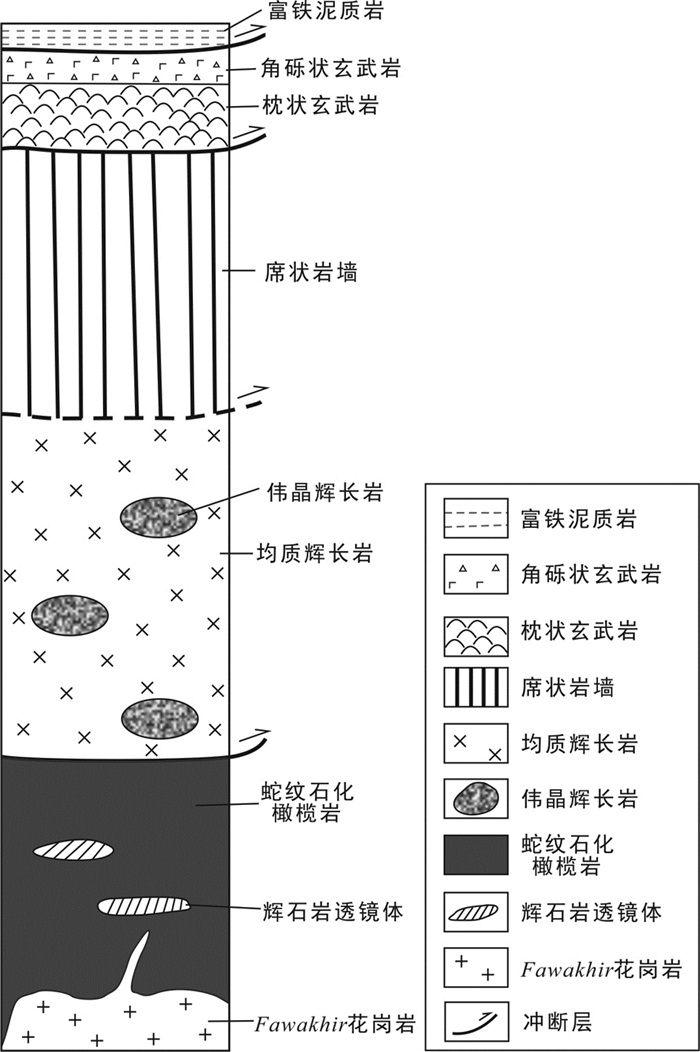
|
图 7 埃及东沙漠区中部(CED)Fawakhir蛇绿岩柱状图(据Abd El-Rahman et al., 2009) Fig. 7 Symbolic column section of the Fawakhir ophiilite in the Central Eastern Desert (CED), Egypt (after Abd El-Ruhman et al., 2009) |
(1) Wizer蛇绿岩
Wizer蛇绿岩纯橄岩中的铬尖晶石以高铬为特征(Cr2O3=59.15%~63.74%; Al2O3=5.88%~9.16%; Cr#=82~88),而方辉橄榄岩的亏损程度呈现较大范围:亏损度高者尖晶石的Cr2O3偏高(Cr2O3=51.43%~60.44%),亏损度低者尖晶石的Cr2O3偏低(Cr2O3=44.44%~49.47%)。总体而言,这些橄榄岩成分总体与弧前橄榄岩相类似,并且铬尖晶石均低TiO2(< 0.17%),支持了Wizer蛇绿岩形成于弧前环境。Wizer蛇绿岩高亏损的方辉橄榄岩中纯橄岩的出现以及纯橄岩中铬尖晶石的玻安质属性符合于俯冲带成因(Farahat et al., 2011)。
Khudeir and Asran (1992)指出,Wizer蛇绿岩中的火山岩显示MORB和岛弧的地球化学属性,且火山岩具有玻安质特征。类似的成因关系在中生代蛇绿岩(如塞浦路斯、阿曼和加利福尼亚地区)中均可见(Batanova and Sobolev, 2000; Léméé et al., 2004; Choi et al., 2008)。Wizer蛇绿岩的火山岩类似于阿曼蛇绿岩的火山岩,兼具MORB和岛弧岩浆岩的特征。Wizer蛇绿岩中从MORB→岛弧拉斑系列(玻安岩)的演化示其形成于弧前环境,这一点已成为研究者的共识(Flower and Dilek, 2003; Arai et al., 2006)。CED的蛇绿岩更像是代表了俯冲带之上完整的弧前-弧-弧后系统。
此外,阿拉姆湾盆地(图 5)发育拉斑玄武质岩石,熔岩和岩墙具有典型岛弧特征(负Nb和Ta异常; Berhe, 1990),属于板内玄武岩→岛弧玄武岩。这些火山岩与蛇纹岩、变辉长岩一起构成肢解的蛇绿岩(Akaad et al., 1995),可能形成于大陆弧后盆地。与蛇绿岩伴生的火山碎屑沉积物含大量陆源组分,确认了东部沙漠区在蛇绿岩和火山沉积岩之下有老的大陆壳出现(El-Gaby et al., 1988)。
(2) Fawakhir蛇绿岩
Fawakhir蛇绿岩各类岩石均落在亚碱性岩石区,低TiO2(TiO2=0.15%~0.73%),属拉斑玄武岩。枕状玄武岩具有中度亏损-轻度富集的LREE配分型式,不同程度的富集Ba和Th,并且具有负Nb异常。辉石岩脉低钛(TiO2=0.07%~0.1%),具有较高的相容元素丰度、较低的REE丰度和LREE亏损的配分型式,并且Zr/Y值较高,具有与玻安质辉长岩同变化的特征(El-Sayed et al., 1999)。晚期的岩墙均富集LILE,亏损Nb,具LREE富集的配分型式。进一步地化特征分析也表明Fawakhir蛇绿岩的成分近似于马里亚纳海沟弧前壳层岩石(Pearce et al., 1984),基性岩成分从拉斑系列过渡到钙碱性系列,包括少量玻安质辉长岩,涵盖了弧型熔岩、柱型、MORB和玻安质岩石区,应形成于弧后盆地(El-Sayed et al., 1999)或者弧前盆地(Andresen et al., 2009)环境,类似于许多显生宙蛇绿岩的形成环境,如西太平洋幼年弧的形成(Stern and Bloomer, 1992; Bloomer et al., 1995)。
2.2.2 SED蛇绿岩 2.2.2.1 野外产状SED蛇绿岩以Abu Dahr(AD)和Wadi Arais(AR)蛇绿岩为代表。SED地区包括5个中-新元古蛇绿岩,其中3个较新鲜(AD、AR和AS)均具有方辉橄榄岩+纯橄岩+铬铁矿组合,其余2个(BL和UH)均强蛇纹石化(见图 5)。
Abu Dahr蛇绿岩推覆体逆冲到片麻岩之上,局部被岛弧变火山岩覆盖,整个层序被同构造或构造后期花岗岩(650~595Ma)所侵入(Moussa et al., 2008)。Abu Dahr蛇绿岩厚度达17km,层序较齐全,包括4个岩相构造单元:基底片麻岩、蛇绿岩组合、岛弧火山岩/火山沉积岩和深成岩组合(同构造或构造后花岗岩侵入体)(图 8)。蛇绿岩底部的地幔岩以方辉橄榄岩为主,含少量纯橄岩;堆晶岩以异剥橄榄岩和辉石岩为代表,与地幔岩顶部的纯橄岩构成过渡带;堆晶岩可见嵌晶结构、填间结构、正堆积结构,并含有副矿物硫化物等。过渡带最上部为辉长岩岩床,向上的壳层岩石为变辉长岩、变斜长岩、基性变火山岩,并被大洋沉积物所覆盖。
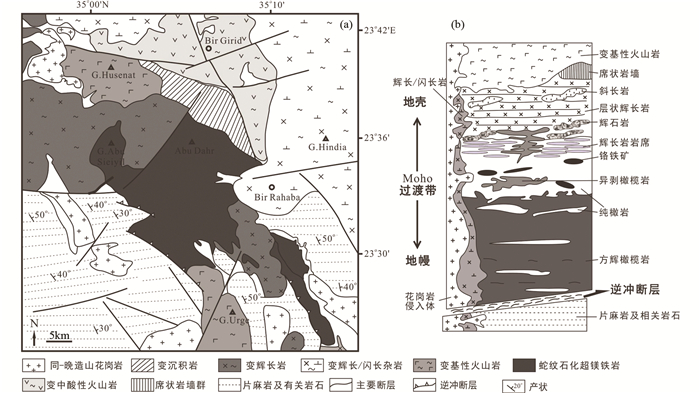
|
图 8 埃及东沙漠区南部(SED) Abu Dahr (AD)蛇绿岩地质简图(a, 据Ashmawy et al., 1987)及柱状图(b, 据Gahlan et al., 2015) Fig. 8 Geological sketch map (a, modified after Ashmawy et al., 1987) and pseudo-lithostratigraphic column (b, after Gahlan et al., 2015) of the Abu Dahr ophiolite in the Southern Eastern Desert (SED), Egypt |
Wadi Arais为SED上保存最好的另一个肢解蛇绿岩,蛇绿岩组合不完整,由地幔岩(蛇纹岩、蛇纹石化橄榄岩和纯橄岩,含铬铁矿)、辉长岩和伟晶辉长岩岩床组成,高度蛇纹石化。各类岩石均被同碰撞的和碰撞后的辉长岩、闪长岩和年轻的辉长岩、闪长岩、花岗岩所侵入(图 9)。
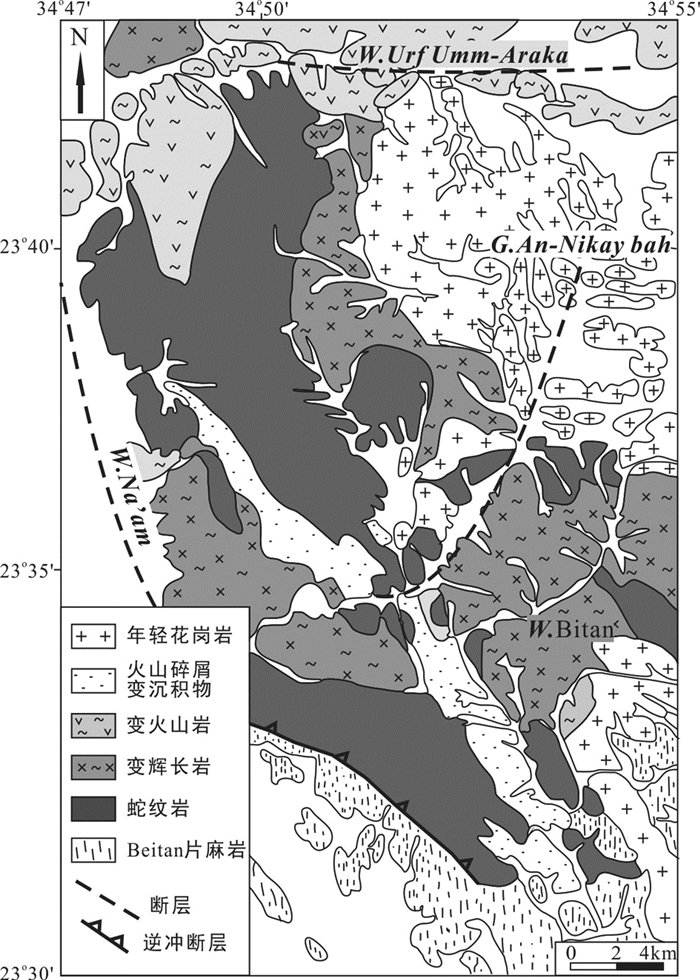
|
图 9 埃及东沙漠区南部(SED)Wadi Arais蛇绿岩地质图(据Khedr and Arai, 2013) Fig. 9 Geological map of the Wadi Arais ophiolite in Southern Eastern Desert (SED) of Egypt (after Khedr and Arai, 2013) |
(1) Abu Dahr蛇绿岩
该蛇绿岩中蛇纹石化橄榄岩高Mg#(0.92~0.93),富Cr、Ni、和Co,亏损Al2O3和CaO,具扁平的REE配分型式。蛇纹石化橄榄岩中铬尖晶石具有高Cr#(>0.6)、低TiO2(大多 < 0.1%)的特点,符合前寒武纪蛇绿岩的普遍特征(Ahmed et al., 2001; Gahlan et al., 2015)。变辉长岩和变玄武岩为亚碱性,具有拉斑系列-钙碱性系列属性,明显富集LILE,具有较高的U/Yb、Th/Yb比值,可能反映岩浆形成于近弧部位。地幔橄榄岩则为弧前橄榄岩及其熔融残余成因(Arai, 1994; Pearce et al., 2000)。值得注意的是,在地幔岩上部的纯橄岩中有小的铬铁矿体(直径10~55m),并常具纯橄岩薄壳。这些高Cr2O3的豆荚状铬铁矿的形成与其形成的弧前构造部位相吻合。上述特征表明Abu Dahr蛇绿岩为亏损的大洋岩石圈残片,经历了高度熔融,形成于弧前部位(Flower and Dilek, 2003),从而提示新元古的构造岩浆作用近似于显生宙,自元古代开始地球的壳-幔热状态无明显变化(Gahlan et al., 2015)。
(2) Wadi Arais蛇绿岩
该蛇绿岩的地幔岩强蛇纹石化,仅在铬铁矿周围见新鲜纯橄岩(达1m),但Ol、Opx、Cpx、Cr-spinel的残晶均可见,矿物具高度耐火特征:(1)方辉橄榄岩中平均Fo=92.2,NiO=0.39%~0.52%;纯橄岩中Fo>94;(2)斜方辉石为顽火辉石,含Cpx出溶板条,并见绢石假象,Mg#=0.92~0.93;(3)单斜辉石为透辉石,Mg#=0.92~0.93,TiO2 < 1%,并且具有“U型REE”;(4)方辉橄榄岩中铬尖晶石的Cr#值变化较宽(0.38~0.85,大多>0.6),覆盖了弧前橄榄岩的成分区;(5)纯橄岩中尖晶石的Cr#>0.8(Arai and Ishimaru, 2008; Arai et al., 2011),结合岩石低Al2O3(平均2.38%)、CaO(0.53%)的特点,近似于现代的弧前橄榄岩(Bizimis et al., 2000; Khedr and Arai, 2013; Obeid et al., 2016)。
Wadi Arais超镁铁岩具有近扁平的REE配分型式,其Mg#值(0.92~0.93)、MgO/SiO2值(0.98~1.04)和Al2O3/SiO2值(0.01~0.02)近似于弧前橄榄岩(Pearce et al., 2000; Niu, 2004),指示其来自地幔源区,经历了高度部分熔融过程。变辉长岩具有拉斑系列-钙碱性系列过渡属性,成分即显示N-MORB特征,也与火山弧玄武岩相类似。蛇纹岩和变辉长岩均富集LILE,提示受到了俯冲带流体的影响(Stolper and Newman, 1994)。
2.2.3 成矿特征CED的豆荚状铬铁矿均以方辉橄榄岩-纯橄岩-铬铁矿组合为特征,近似于显生宙蛇绿岩(Ahmed et al., 2001),广泛见于上述6个蛇绿岩区(图 5)。豆荚状铬铁矿常呈大小不等的小透镜状,透镜体长 < 30m或呈棒状(3m×7m),主要寄主于蛇纹石化纯橄岩中,脉石矿物为利蛇纹石、纤维蛇纹石等,可见网环结构。橄榄岩全部蛇纹石化、可见Opx的绢石假象,方辉橄榄岩很近似于太平洋现代快速扩张脊的深海橄榄岩(Niu and Hékinian, 1997)。铬铁矿中有时可见Ol、Cpx、含水矿物(浅闪石、透闪石、金云母)原生矿物包体(如Wadi El-Zarka和Wadi Um Huitate区)(Ahmed et al., 2001)。
Ahemd et al. (2001)首次报导了CED的UH区(图 5)的铬铁矿豆荚中有韭闪石、透闪石和金云母的包体。铬尖晶石中可见原生包裹体矿物,包括高MgO橄榄石(Fo平均为97.5)、透辉石(Mg#=0.97~0.98),且低Na2O、Al2O3,尚见浅闪石、透闪石及金云母。Khudeir and Asran (1992)对中部沙漠区介于RB区和UH区之间6个矿点的铬铁矿矿石分析揭示了2个成分组:一组为高铝组(Cr#=0.56)(2个矿点),另一组为低铝组(Cr#=0.73)(4个矿点),从而显示了类似阿尔卑斯橄榄岩的双峰性特征。CED铬铁矿的成分变化较大(从高铬型→高铝型),Cr2O3=41%~65%,Al2O3=6%~29%,Cr#变化于0.5~0.9之间(高Cr者Cr#=0.73,高Al者Cr#=0.56),Fe+3=0.08~0.20),显示铬尖晶石不同程度受到低温蚀变。高铝组可能在较高压力和较低温度下结晶(较第2组),这种橄榄岩具有“弧”或“大洋高原”成因,而非洋中脊成因(El-Haddad and Khudeir, 1989),源区更可能是岛弧的深根部(Khudeir and Asran, 1992)。
SED中铬铁矿石的Cr#变化较窄(0.8~0.9),但均低TiO2(< 0.29%)。部分与泛非豆荚状铬铁矿相伴的橄榄岩中的铬尖晶石含有较高的MnO(可达1.79%),不同于显生宙和其它的元古代铬铁矿中的铬尖晶石含MnO较低的特点,如中生代的阿曼铬铁矿(MnO < 0.14%)(Augé, 1987)和早元古代的芬兰Outokumpu-Jormua铬铁矿(MnO < 0.29%)(Liipo et al., 1995)。铬铁矿被包在块状或片状的蛇纹岩中,矿体和蛇纹岩因泛非蛇绿岩质混杂岩的仰冲而高度变形。新鲜的铬铁矿Cr2O3=51%~53%,蚀变成铁铬铁矿(ferrichromite)。块状、豆状和浸染状状矿石具堆晶结构(Khudeir and Asran, 1992)。在SED区有时可见新鲜的Ol和Opx,但未见原生的含水矿物包体。
此外,CED和SED的铂族元素(PGE)构成迥异,前者主要为硫化物(Os-rich硫钌锇矿),后者则为Os-Ir合金。硫的“逸度”(fS2)及温度控制了上地幔初始阶段铬铁矿的PGE矿物学,Os-rich硫钌锇矿在高的fS2及低温度下稳定,而Os-Ir合金在低的硫fS2及高温度下稳定,结合铬铁矿的成分差异提示了CED区和SED区地幔岩部分熔融程度的差异,即归因于不同的构造环境(Ahmed, 2007)。但CED区和SED区的铬尖晶石均以低TiO2(< 0.29%)为特征,类似于蛇绿岩中者。埃及的新元古代大洋岩石圈碎片可能受与弧有关的岩浆作用的改造,或属于弧后盆地岩石圈。CED区铬铁矿的铬尖晶石含有Os-rich硫钌锇矿,反映寄主铬尖晶石形成于较高的fS2及较低温度下,而较高的fS2及较低温条件在俯冲带环境的高度部分熔融的熔体中可以获得,可以认为埃及新元古代蛇绿岩初始形成于洋中脊环境,后来受到俯冲带环境下的改造。
2.2.4 小结综上不难看出,埃及东部沙漠区的新元古代蛇绿岩和显生宙蛇绿岩具有相似的岩石学特征,表明控制地球壳-幔系统的热状态自新元古代无明显变化。埃及东部沙漠区的蛇绿岩与显生宙的阿曼蛇绿岩可类比,可能形成于岛弧环境(MacLeod et al., 2013; Guilmette et al., 2018),特别是在Oman蛇绿岩北部玻安质熔岩的发现(Ishikawa et al., 2002)以及high-PGE铬铁矿的存在,揭示了它们是由俯冲带环境下高度熔融的熔体结晶作用的产物,而low-PGE铬铁矿产于过渡带,是由较早洋中脊的低度熔融的熔体的结晶作用的产物(Ahmed and Arai, 2002)。埃及蛇绿岩和铬铁矿形成于俯冲带演化的不同阶段,高铝型铬铁矿不含原生矿物包体,是在俯冲初始软流圈因减压融化形成MORB型的拉斑玄武质熔体,此时板块脱水形成的流体有限,故形成高铝型铬铁矿,矿石也不含原生的含水包体;当进入成熟弧阶段时,发生二次熔化形成玻安质和岛弧熔体时,形成高铬型铬铁矿,并伴有纯橄岩壳、高亏损方辉橄榄岩的形成(Whattam and Stern, 2011; moghadam et al., 2015)。
2.3 非洲中-新元古代蛇绿岩及铬铁矿 2.3.1 野外产状非洲中-新元古代蛇绿岩主要分布于北非东部和东非地区,属阿拉伯-努比亚地盾(Arabian-Nubian Shield,简称ANS)的努比亚段。ANS为新元古代年轻大陆地壳分布最广泛的地区,这些年轻的陆壳包括洋间岛弧/弧后盆地杂岩和微型大陆,当莫桑比克洋封闭时沿缝合带焊接而成(Abu-Alam and Hamdy, 2014)。从北部的沙特阿拉伯和埃及向南延伸→埃塞俄比亚和苏丹→再向南至乌干达-肯尼亚→索马里均有中-新云古代蛇绿岩的分布。该地区有大量的与弧有关的火山岩-深成岩,并伴有若干缝合带(图 10)。这些缝合带呈近北北东向,从西向东依次为:①Sol Hamed-Wadi Onib belt;②Ingessana-Port Sudan belt;③Sekerr-Yubdo-Barka belt;④Bargoi-Nabitah belt;⑤Adola-Moyale belt。蛇绿岩散布在3000 ×1000km2的范围内。ANS的努比亚段(即非洲段)有许多蛇绿岩产出(Zimmer et al., 1995; Hussein et al., 2004; Johnson et al., 2004),以推覆杂岩出现,其时代为690~890Ma。蛇绿岩的时代与罗迪尼亚超大陆(Rodinia)的裂解(ca.900~800Ma)相伴(Stern, 1994; Hassan et al., 2014),这些洋壳碎片随莫桑比克洋闭合时(约600Ma)(Meert,2003)的“弧-弧”碰撞被逆冲到大陆边缘(800~700Ma)(Pallister et al., 1988; Johnson et al., 2004)。

|
图 10 北非东部新元古蛇绿岩带分布示意图(据Berhe, 1986简修) Fig. 10 Distribution sketch map of Late Proterozoic ophiolite belts of NE Africa (modified after Berhe, 1986) |
尽管蛇绿岩被肢解,但标志性组合仍然可见。蛇绿岩的壳层厚度为2.5~5km,其中堆晶超镁铁岩(过渡带)的厚度1~3km,底部含有铬铁矿。本文将讨论苏丹北部Sol Hamed-Wadi Onib缝合带的蛇绿岩,该缝合带蛇绿岩密集分布(图 11),为“弧-弧”碰撞的典型实例(Abu-Alam and Hamdy, 2014),包含Wadi Onib蛇绿岩和Sol Hamed蛇绿岩两部分,它们都具有较完整的蛇绿岩组合。

|
图 11 北非东部Onib-Sol Hamed缝合带蛇绿岩及Hamisana剪切带地质简图(据Stern et al., 1989; Hussein et al., 1982修编) Fig. 11 Geological sketch map of the Onib-Sol Hamed suture zone and the Hamisana shear zone of NE Africa ophiolite (modified after Stern et al., 1989; Hussein et al., 1982) |
Wadi Onib蛇绿岩位于缝合带的南端,蛇绿岩组合齐全,由底部的橄榄岩→过渡带(堆晶岩、均质辉长岩和斜长花岗岩)→基性席状岩床杂岩→枕状熔岩组成(含条带状燧石熔岩→泥质碳酸岩)(Hussein et al., 2004)。Onib蛇绿岩被包在受多期变形、与弧有关的弱变质火山碎屑沉积岩层中,且二者之间为逆冲断层。蛇绿岩单元均被后期花岗岩和辉长岩等侵入(Hussein et al., 2004)(图 12、图 13)。基底橄榄岩全蛇纹石化和/或碳酸盐化,具叶理和片理。过渡带显示多旋回特征,具粒级层和重力分层,含大量辉石岩(某些辉石岩富铬)。岩墙单元广泛发育并且经历不同程度的变形,包括辉绿岩质、闪长岩质、斑状斜长角闪岩质的岩墙和岩床,宽约几厘米到几米,可延伸数十米,以具不对称冷凝边为特征,显示多期侵入的特点,为古大洋岩石圈海底扩张的证据。火山岩露头可由块状和枕状玄武岩、角砾岩、岩床和岩墙构成,可见枕状构造,枕间物质为绿泥石和石英等,部分枕状熔岩被岩墙所侵入(Hussein et al., 2004)。深海沉积物不发育,常作为岩枕填隙物(燧石、石墨质、碳酸岩)出现。Onib蛇绿岩中斜长花岗岩的锆石Pb-Pb年龄为808±14Ma(Kröner et al., 1992),而切穿层状辉长岩的花岗岩年龄为714~646Ma,可能反映了洋盆关闭后板内岩浆作用阶段(Kröner et al., 1992)。

|
图 12 Wadi Onib蛇绿岩地质简图(据Hussein, 2000简化) Fig. 12 Geological sketch map of the Wadi Onib ophiolite (simplified after Hussein, 2000) |
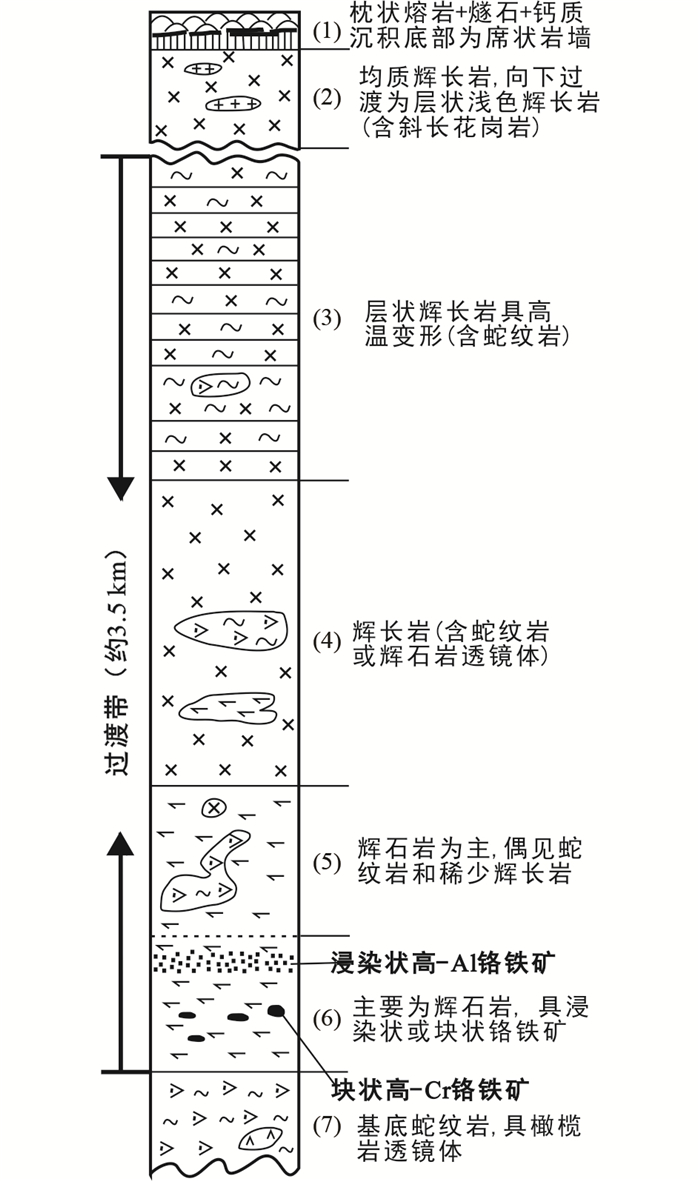
|
图 13 Wadi Onib蛇绿岩柱状图(据Hussein, 2000简化) Fig. 13 The columnar section of the Wadi Onib ophiolite (simplified after Hussein, 2000) |
Sol Hamed蛇绿岩位于缝合带北端,呈NE-SW向,为ANS上不常见的变形较轻的蛇绿岩。该蛇绿岩具有几乎完整的层序,由超镁铁岩→辉长岩、席状岩墙→枕状熔岩和枕状角砾岩组成,为一直立状仰冲推覆体,被含蛇绿岩碎屑的角砾岩、滑塌堆积、长英质和英安质凝灰岩、浊积岩和黑色页岩等(Nafirdeib岩系;712±58Ma)所不整合覆盖(Hussein, 1977)(图 14)。Nafirdeib岩系火山岩具钙碱性属性(Pearce, 1982; Fitches et al., 1983),其全岩Rb-Sr定年结果为723±6Ma(Stern and Kröner, 1993)。Nafirdeib岩系和蛇绿岩均被年轻的花岗岩(全岩Rb/Sr定年结果为686±18Ma和633±19Ma)所侵入。这些花岗岩具有较低的87Sr/86Sr值,指示其岩浆来源于下地壳或地幔。这些火山岩、沉积层序以及钙碱性花岗岩暗示了俯冲带之上的大洋岛弧环境(Neary et al., 1976)。
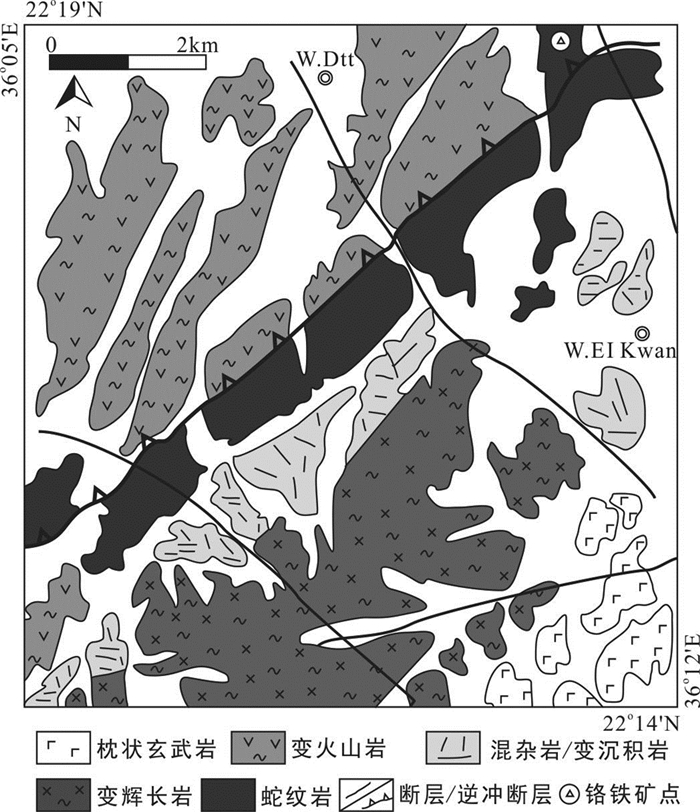
|
图 14 Sol Hamed蛇绿岩地质图(据Abu El-Laban, 2002修编) Fig. 14 Geological map of the Sol Hamed ophiolite (modified after Abu El-Laban, 2002) |
Sol Hamed蛇绿岩呈NE向,由3个岩带组成。(1)底部带为超镁铁岩带,长20km左右,宽0.3~3km,包括蛇纹岩、含铬铁矿纯橄岩、纯橄岩、异剥橄榄岩和二辉橄榄岩,可能有方辉橄榄岩(可见绢石及单斜辉石)及少量辉石岩。纯橄岩可见少量Ol残晶,具网环结构,其中常见铬铁矿的粒级层(厚0.5~2cm),而较厚的豆荚状铬铁矿仅局部见于蛇绿岩东北部,为岩浆分异的产物。异剥橄榄岩由橄榄石(已蛇纹石化)和新鲜单斜辉石组成,二辉橄榄岩由橄榄石(已蛇纹石化)+新鲜Cpx+绢石(Opx假象)组成。(2)中部带为辉长岩带,长20km左右,宽4~6km,为层状辉石辉长岩-浅色辉长岩-斜长质辉长岩组合,已发生中-高绿片岩相变质。辉长岩中可见异剥橄榄岩岩席(厚100m,长1km),可能为辉长岩内的超镁铁堆晶单元。底部和中部带两单元多为构造接触。(3)上部带由枕状熔岩和枕状角砾岩组成,部分岩枕可见冷凝边(Abu El-Laban, 2002)。
2.3.2 岩石地球化学特征Onib蛇绿岩中蛇纹岩的地球化学资料以高MgO(34%~37%)、Cr(2287×10-6~3829×10-6)和NiO(1255×10-6~2049×10-6),低TiO2(0.01%~0.02%)和P2O5为特征,其中的橄榄石富镁(Fo=88,Mg#=0.81)。辉石岩以透辉石为主,包括富橄榄石的单辉辉石岩和异剥橄榄岩,辉石岩高CaO(17%)和Cr(5121×10-6~5238×10-6),亏损碱、P2O5和TiO2。均质辉长岩中的斜长花岗岩具高SiO2(70%~77%)、低K2O(0.04%~1.9%)的特点(Abdel-Rahman, 1993)。67个熔岩样品的REE配分型式既有LREE富集型,也有LREE亏损型。大多数熔岩的Ti/V=20~50,与洋中脊、弧后盆地和板内玄武岩相接近,少数熔岩的Ti/V < 20,显示出岛弧拉斑玄武岩和钙碱性玄武岩的特征。总体而言,大部分熔岩具有MORB、弧玄武岩和板内玄武岩的组合特征。上述地球化学特征与俯冲消减带岩浆弧类似。
Sol Hamed蛇绿岩中蛇纹岩的岩石化学计算示其为方辉橄榄岩的蚀变产物,高Cr(2696×10-6~2742×10-6)和Ni(1650×10-6~2381×10-6)(McDonough and Sun, 1995)。所有的蛇纹岩都含有铬铁矿(具蚀变分带)和硫化物,且铬尖晶石的Cr#大于0.6,符合弧前环境(Church, 1988)。利用全岩的V和MgO数据计算蛇绿岩的部分熔融程度为26%~29%,也示其为弧前成因(Lee et al., 2003)。Sol Hamed蛇绿岩周围大量钙碱性火山岩和火山碎屑岩的出现暗示了蛇绿岩形成于岛弧环境。
2.3.3 成矿特征在Onib蛇绿岩中可见浸染状高铝型铬铁矿和有限的高铬型铬铁矿,其中前者显示堆晶结构——即铬尖晶石(含量≥30%)在辉石晶体中呈嵌晶状。高铬型铬尖晶石在寄主蛇纹岩中含量达80%,与蛇纹石叶片交生,显示粗略层理,局部可见铬铁矿的粒级层,指示岩浆分异和旋回堆晶作用(Hussein et al., 2004)。Onib蛇绿岩中双峰值(高铝型和高铬型)铬铁矿的出现可能形成于洋中脊、弧后盆地等多种环境(Hawkins and Evans, 1983; Dick and Bullen, 1984)。然而,豆荚状铬铁矿的出现以及堆晶辉石岩亏损Ti的特点被认为属典型的俯冲带蛇绿岩(Kröner et al., 1987)。
Sol Hamed蛇绿岩中的铬铁矿成不同大小的透镜体(可达25×6m2),多寄主于纯橄岩中,野外可见从纯橄岩中的细粒浸染状铬铁矿→瘤状→块状粗粒铬铁矿的过渡,而在蛇纹石化橄榄岩中则为小透镜体或薄板状,高度变形的铬铁矿最丰富。铬尖晶石的TiO2较高,投影在弧前橄榄岩和高Ti玻安岩区,说明俯冲带环境下富Ti熔体可能与堆晶纯橄岩起反应,从而形成了Sol Hamed蛇绿岩中高铬型的铬铁矿(Hamdy and Lebda, 2011)。
2.3.4 小结Onib蛇绿岩形成于808Ma以前,因此蛇绿岩的演化证明了现代的板块构造可扩展至早元古代,并构成了Sol Hamed-Wadi Onib蛇绿岩带。Sol Hamed-Wadi Onib缝合带的蛇绿岩具有组合齐全、堆晶岩厚度较大、岩墙发育,岩浆显示多期活动的特征,铬铁矿均为岩浆分异的产物。
3 结论(1) 元古代蛇绿岩代表移置的古大洋岩石圈残片,产于古缝合带中,并与弧火山岩和(或)火山碎屑岩(和或混杂岩)伴生。这些被肢解的蛇绿岩大多数组合较齐全,尤以镁铁-超镁铁岩、基性岩墙及火山岩发育为特征,具开放岩浆房的多期活动的特点,岩石大多受绿片岩-角闪岩相变质。地幔橄榄岩或缺失(如加拿大Purtuniq蛇绿岩及北非东部蛇绿岩)、或已全蛇纹石化(如埃及CED蛇绿岩),仅少数地幔橄榄岩中保留残晶(如埃及SED蛇绿岩)。综合地球化学资料可知,中-新元古代蛇绿岩形成于弧前盆地或俯冲带环境,早元古代蛇绿岩则形成于大陆裂谷-大洋演化阶段,提供了元古代板块构造演化的证据。
(2) 元古代蛇绿岩中常赋存高铝型(Cr# < 0.6)和高铬型(Cr#>0.6)两种铬铁矿,它们多寄主于纯橄岩中,部分高铝型铬铁矿则寄主于近莫霍面的辉长岩底部(如芬兰的Outokumpu蛇绿岩),且高铬型铬铁矿中可见含水包裹体(如CED中的铬铁矿、北非东部蛇绿岩中的铬铁矿)——揭示了水参与了高铬型铬铁矿的成矿作用。两类铬铁矿均以低TiO2为特征。矿体规模均较小,可见矿石从浸染状→瘤状→块状的逐渐过渡。据资料中照片提供的“矿体周围的纯橄岩薄壳”,笔者认为:这些所谓的“薄壳”明显区别于显生宙纯橄岩-方辉橄榄岩高熔杂岩带中的豆荚状铬铁矿。结合元古代镁铁-超镁铁岩中堆晶结构以及粒级层的出现,可以确认这些铬铁矿为岩浆分异成因,而区别于熔融残余成因的豆荚状铬铁矿。元古代蛇绿岩中常伴有交代成因的硫化物Cu-Co-Zn-Au矿(如Outokumpu蛇绿岩)、Cu-Au矿带(如赣东北前寒武纪蛇绿岩),且铬铁矿含较高的Zn(ZnO=0.11%~0.18%,如Outokumpu蛇绿岩)、橄榄岩及铬铁矿中常含较高的MnO(MnO高达1.79%,如CED的Wizer蛇绿岩),而区别与显生宙蛇绿岩。
致谢 本文撰写过程中得到了中国地质科学院地质研究所翟庆国研究员、胡培远副研究员以及唐跃、王伟、王海涛和朱志才博士的帮助,在此一并致谢。
谨以此文祝贺肖序常院士90华诞!
Abd El-Rahman EM. 1993. Geochemical and geotectonic controls of the metallogenic evolution of selected ophiolite complexes from the Sudan. Berliner: Berliner Geowissenschaftliche Abhandlungen, A145: 175
|
Abd El-Rahman Y, Polat A, Dilek Y, Fryer BJ, El-Sharkawy M and Sakran S. 2009. Geochemistry and tectonic evolution of the Neoproterozoic incipient arc-forearc crust in the Fawakhir area, Central Eastern Desert of Egypt. Precambrian Research, 175(1-4): 116-134 DOI:10.1016/j.precamres.2009.09.008 |
Abu El-Laban SA. 2002. Some geological and geochemical studies in Abu Ramad Area, South Eastern Desert, Egypt. Ph. D. Dissertation. Cairo: Cairo University, 274
|
Abu-Alam TS and Hamdy MM. 2014. Thermodynamic modelling of Sol Hamed serpentinite, South Eastern Desert of Egypt:Implication for fluid interaction in the Arabian-Nubian Shield ophiolites. Journal of African Earth Sciences, 99: 7-23 DOI:10.1016/j.jafrearsci.2014.06.001 |
Ahmed AH, Arai S and Attia AK. 2001. Petrological characteristics of podiform chromitites and associated peridotites of the Pan African Proterozoic ophiolite complexes of Egypt. Mineralium Deposita, 36(1): 72-84 DOI:10.1007/s001260050287 |
Ahmed AH and Arai S. 2002. Unexpectedly high-PGE chromitite from the deeper mantle section of the northern Oman ophiolite and its tectonic implications. Contributions to Mineralogy and Petrology, 143(3): 263-278 DOI:10.1007/s00410-002-0347-8 |
Ahmed AH. 2007. Diversity of platinum-group minerals in podiform chromitites of the Late Proterozoic ophiolite, Eastern Desert, Egypt:Genetic implications. Ore Geology Reviews, 32(1-2): 1-19 DOI:10.1016/j.oregeorev.2006.05.008 |
Akaad MK, Noweir AM and Abu El-Ela AM. 1995. The volcano-sedimentary association and ophiolites of Wadi Mubarak, Eastern Desert, Egypt. In: Proc. Int. Conference. 30 Years Cooper. Geological Survey of Egypt (Special Publish), 69: 231-248
|
Akaad MK and Abu El-Ela AM. 2002. Geology of the basement rocks in the eastern half of the belt between latitudes 25°30' and 26°30'N, Central Eastern Desert, Egypt. Geological Survey of Egypt, 78: 118 |
Andresen A, Ali Abu El-Rus M, Myhre PI, Boghdady GY and Corfu F. 2009. U-Pb TIMS age constraints on the evolution of the Neoproterozoic Meatiq Gneiss Dome, Eastern Desert, Egypt. International Journal of Earth Sciences, 98(3): 481-497 DOI:10.1007/s00531-007-0276-x |
Arai S. 1994. Characterization of spinel peridotites by olivine-spinel compositional relationships:Review and interpretation. Chemical Geology, 113(3-4): 191-204 DOI:10.1016/0009-2541(94)90066-3 |
Arai S, Kadoshima K and Morishita T. 2006. Widespread arc-related melting in the mantle section of the northern Oman ophiolite as inferred from detrital chromian spinels. Journal of the Geological Society, 163(5): 869-879 DOI:10.1144/0016-76492005-057 |
Arai S and Ishimaru S. 2008. Insights into petrological characteristics of the lithosphere of mantle wedge beneath arcs through peridotite xenoliths:A review. Journal of Petrology, 49(4): 665-695 |
Arai S, Okamura H, Kadoshima K, Tanaka C, Suzuki K and Ishimaru S. 2011. Chemical characteristics of chromian spinel in plutonic rocks:Implications for deep magma processes and discrimination of tectonic setting. Island Arc, 20(1): 125-137 DOI:10.1111/j.1440-1738.2010.00747.x |
Ashmawy MH. 1987. The ophiolitic mélange of the South Eastern Desert of Egypt:Remote sensing, field work and petrographic investigations. Berliner:Berliner Geowissenschaftliche Abhandlungen, 84(A): 135 |
Augé T. 1987. Chromite deposits in the northern Oman ophiolite:Mineralogical constraints. Mineralium Deposita, 22(1): 1-10 |
Azer MK and Stern RJ. 2007. Neoproterozoic (835~720Ma) serpentinites in the Eastern Desert, Egypt:Fragments of forearc mantle. The Journal of Geology, 115(4): 457-472 DOI:10.1086/518052 |
Batanova VG and Sobolev AV. 2000. Compositional heterogeneity in subduction-related mantle peridotites, Troodos massif, Cyprus. Geology, 28(1): 55-58 |
Bégin NJ. 1989. P-T conditions of metamorphism inferred from the metabasites of the Cape Smith Belt, northern Quebec. Geoscience Canada, 16(3): 151-154 |
Berhe SM. 1986. Geologic and geochronologic constraints on the evolution of the Red Sea-Gulf of Aden and Afar Depression. Journal of African Earth Sciences (1983), 5(2): 101-117 DOI:10.1016/0899-5362(86)90001-1 |
Berhe SM. 1990. Ophiolites in Northeast and East Africa:Implications for Proterozoic crustal growth. Journal of the Geological Society, 147(1): 41-57 DOI:10.1144/gsjgs.147.1.0041 |
Bickle MJ. 1986. Implications of melting for stabilisation of the lithosphère and heat loss in the Archaean. Earth and Planetary Science Letters, 80(3-4): 314-324 DOI:10.1016/0012-821X(86)90113-5 |
Bizimis M, Salters VJM and Bonatti E. 2000. Trace and REE content of clinopyroxenes from supra-subduction zone peridotites. Implications for melting and enrichment processes in island arcs. Chemical Geology, 165(1-2): 67-85 DOI:10.1016/S0009-2541(99)00164-3 |
Bloomer SH, Taylor B, MacLeod CJ, Stern RJ, Fryer P, Hawkins JW and Johnson L. 1995. Early arc volcanism and the ophiolite problem: A perspective from drilling in the Western Pacific. In: Taylor B and Natland J (eds.). Active Margins and Marginal Basins of the Western Pacific. Washington, DC: American Geophysical Union, 88: 1-30
|
Choi SH, Shervais JW and Mukasa SB. 2008. Supra-subduction and abyssal mantle peridotites of the coast range ophiolite, California. Contributions to Mineralogy and Petrology, 156(5): 551-576 DOI:10.1007/s00410-008-0300-6 |
Church WR. 1988. Ophiolites, sutures, and micro-plates of the Arabian-Nubian Shield: A critical comment. In: El Gaby S and Greiling RO (eds.). The Pan-African Belt of Northeast Africa and Adjacent Areas. Braunschweig/Wiesbaden: Friedr Vieweg Sohn, 289-316
|
Claesson S, Huhma H, Kinny PD and Williams IS. 1993. Svecofennian detrital zircon ages:Implications for the Precambrian evolution of the Baltic Shield. Precambrian Research, 64(1-4): 109-130 DOI:10.1016/0301-9268(93)90071-9 |
Coleman RG. 1977. Ophiolites. New York: Springer, 1-220
|
Dick HJB and Bullen T. 1984. Chromian spinel as a petrogenetic indicator in abyssal and alpine-type peridotites and spatially associated lavas. Contributions to Mineralogy and Petrology, 86(1): 54-76 DOI:10.1007/BF00373711 |
Dickey JS Jr. 1975. A hypothesis of origin for podiform chromite deposits. Geochimica et Cosmochimica Acta, 39(6-7): 1061-1074 DOI:10.1016/0016-7037(75)90047-2 |
Dilek Y and Furnes H. 2011. Ophiolite genesis and global tectonics:Geochemical and tectonic fingerprinting of ancient oceanic lithosphere. Geological Society of America Bulletin, 123(3-4): 387-411 DOI:10.1130/B30446.1 |
Dunning GR. 1987. Geology of the Annieopsquotch complex, Southwest Newfoundland. Canadian Journal of Earth Sciences, 24(6): 1162-1174 DOI:10.1139/e87-112 |
EI-Haddad MA and Khudeir AA. 1989. Geological and geochemical studies on some chromite deposits in the Central Eastern Desert. Bulletin of the Faculty of Science, Assiut University, 13: 141-158
|
El-Gaby S, List FK and Tehrani R. 1988. Geology, evolution and metallogenesis of the Pan-African belt in Egypt. In: El Gaby S and Greiling RO (eds.). The Pan-African Belt of Northeast Africa and Adjacent Areas. Wiesbaden: Vieweg, 17-65
|
El-Sayed MM, Furnes H and Mohamed FH. 1999. Geochemical constraints on the tectonomagmatic evolution of the late precambrian fawakhir ophiolite, Central Eastern Desert, Egypt. Journal of African Earth Science, 29(3): 515-533 DOI:10.1016/S0899-5362(99)00113-X |
Farahat ES, El Mahallawi MM, Hoinkes G, Abdel Aal AY and Hauzenberger CA. 2010. Pillow form morphology of selected Neoproterozoic metavolcanics in the Egyptian Central Eastern Desert and their implications. Journal of African Earth Sciences, 57(1-2): 163-168 DOI:10.1016/j.jafrearsci.2009.09.001 |
Farahat ES, Hoinkes G and Mogessie A. 2011. Petrogenetic and geotectonic significance of Neoproterozoic suprasubduction mantle as revealed by the Wizer ophiolite complex, Central Eastern Desert, Egypt. International Journal of Earth Sciences, 100(7): 1433-1450 DOI:10.1007/s00531-010-0592-4 |
Fitches WR, Graham RH, Hussein IM, Ries AC, Shackleton RM and Price RC. 1983. The Late Proterozoic ophiolite of Sol Hamed, NE Sudan. Precambrian Research, 19(4): 385-411 DOI:10.1016/0301-9268(83)90022-0 |
Flower MFJ and Dilek Y. 2003. Arc-trench rollback and forearc accretion: 1. A collision-induced mantle flow model for Tethyan ophiolites. In: Dilek Y and Robinson PT (eds.). Ophiolites in Earth History. Geological Society, London, Special Publications, 218(1): 21-41
|
Furnes H, El-Sayed MM, Khalil SO and Hassanen MA. 1996. Pan-African magmatism in the Wadi El-Imra District, Central Eastern Desert, Egypt:Geochemistry and tectonic environment. Journal of the Geological Society, 153(5): 705-718 DOI:10.1144/gsjgs.153.5.0705 |
Gahlan HA, Azer MK and Khalil AES. 2015. The Neoproterozoic abu dahr ophiolite, South Eastern Desert, Egypt:Petrological characteristics and tectonomagmatic evolution. Mineralogy and Petrology, 109(5): 611-630 DOI:10.1007/s00710-015-0397-z |
Garson MS and Shalaby IM. 1976. Precambrian-Lower Paleozoic plate tectonics and metallogenesis in the Red Sea region. Geological Association of Canada Special Paper, 14: 573-596 |
Guilmette C, Smit MA, van Hinsbergen DJJ, Gürer D, Corfu F, Charette B, Maffione M, Rabeau O and Savard D. 2018. Forced subduction initiation recorded in the sole and crust of the Semail ophiolite of Oman. Nature Geoscience, 11(9): 688-695 DOI:10.1038/s41561-018-0209-2 |
Hamdy MM and Lebda EMM. 2011. Al-compositional variation in ophiolitic chromitites from the South Eastern Desert of Egypt:Petrogenetic implications. Journal of Mining and Geology, 3: 232-250 |
Hassan M, Abu-Alam TS, Stüwe K, Fowler A and Hassen I. 2014. Metamorphic evolution of the Sa'al-zaghra complex in Sinai:Evidence for Mesoproterozoic rodinia break-up?. Precambrian Research, 241: 104-128 DOI:10.1016/j.precamres.2013.11.013 |
Hawkins JW and Evans CA. 1983. Geology of the Zambales Range, Luzon, Philippine Islands: Ophiolite derived from an island arc-back arc basin pair. In: Hayes DE (ed.). The Tectonic and Geologic Evolution of Southeast Asian Seas and Islands: Part 2. Washington DC: American Geophysical Union, 27: 95-123
|
Hegner E and Bevier ML. 1989. Geochemical constraints on the origin of mafic rocks from the Cape Smith Belt. Geoscience Canada, 16(3): 148-151 |
Hoffman PF. 1985. Is the cape smith belt (northern Quebec) a klippe?. Canadian Journal of Earth Sciences, 22(9): 1361-1369 DOI:10.1139/e85-140 |
Huhma H. 1986. Sm-Nd, U-Pb and Pb-Pb isotopic evidence for the origin of the Early Proterozoic svecokarelian crust in Finland. Bulletin of the Geological Society of Finland, 337: 48 |
Hussein IM. 1977. Geology of the Halaib area of the northern Red Sea Hills, Sudan, with special reference to the Sol Hamid basic complex. Master Degree Thesis. Portsmouth: Portsmouth Polytechnic, 1-175
|
Hussein IM, Kröner A and Dürr S. 1982. Wadi Onib:A dismembered Pan-African ophiolite in the Red Sea Hills of the Sudan. Precambrian Research, 16(4): A52 |
Hussein IM. 2000. Geodynamic evolution of the Pan-African crystalline basement in the northern Red Sea Hills, Sudan, with special emphasis on the Wadi Onib ophiolite and the geology to the west of Port Sudan. Ph. D. Dissertation. Germany: University of Mainz
|
Hussein IM, Kröner A and Reischmann T. 2004. The Wadi Onib mafic-ultramafic complex:A neoproterozoic supra-subduction zone ophiolite in the northern Red Sea Hills of the Sudan. Developments in Precambrian Geology, 13: 163-206 DOI:10.1016/S0166-2635(04)13005-3 |
Ishikawa T, Nagaishi K and Umino S. 2002. Boninitic volcanism in the Oman ophiolite:Implications for thermal condition during transition from spreading ridge to arc. Geology, 30(10): 899-902 DOI:10.1130/0091-7613(2002)030<0899:BVITOO>2.0.CO;2 |
Jan MQ and Windley BF. 1990. Chromian spinel-silicate chemistry in ultramafic rocks of the Jijal complex, Northwest Pakistan. Journal of Petrology, 31(3): 667-715 DOI:10.1093/petrology/31.3.667 |
Johnson PR, Kattan FH and Al-Saleh AM. 2004. Neoproterozoic ophiolites in the Arabian Shield:Field relations and structure. Developments in Precambrian Geology, 13: 129-162 DOI:10.1016/S0166-2635(04)13004-1 |
Jöns N and Schenk V. 2008. Relics of the Mozambique Ocean in the central East African Orogen:Evidence from the Vohibory block of southern Madagascar. Journal of Metamorphic Geology, 26(1): 17-28 |
Khedr MZ and Arai S. 2013. Origin of Neoproterozoic ophiolitic peridotites in South Eastern Desert, Egypt, constrained from primary mantle mineral chemistry. Mineralogy and Petrology, 107(5): 807-828 DOI:10.1007/s00710-012-0213-y |
Khudeir AA and Asran HA. 1992. Back-arc Wizer ophiolites at Wadi Um Gheig district, Eastern Desert, Egypt. Bulletin of Faculty of Science, Assiut University, 21: 1-22 |
Koistinen TJ. 1981. Structural evolution of an Early Proterozoic strata-bound Cu-Co-Zn deposit, Outokumpu, Finland. Earth and Environmental Science Transactions of the Royal Society of Edinburgh, 72(2): 115-158 DOI:10.1017/S0263593300009949 |
Kontinen A. 1987. An Early Proterozoic ophiolite:The jormua mafic-ultramafic complex, northeastern Finland. Precambrian Research, 35: 313-341 DOI:10.1016/0301-9268(87)90061-1 |
Kröner A, Grieling R, Reischmann T, Hussein IM, Stern RJ, Dürr S, Krüger J and Zimmer M. 1987. Pan-African crustal evolution in the Nubian segment of Northeast Africa. In: Kröner A (ed.). Proterozic Lithospheric Evolution. Washington, DC: American Geophysical Union, 17: 237-257
|
Kröner A, Todt W, Hussein IM, Mansour M and Rashwan AA. 1992. Dating of late Proterozoic ophiolites in Egypt and the Sudan using the single grain zircon evaporation technique. Precambrian Research, 59(1-2): 15-32 DOI:10.1016/0301-9268(92)90049-T |
Le Mée L, Girardeau J and Monnier C. 2004. Mantle segmentation along the Oman ophiolite fossil mid-ocean ridge. Nature, 432(7014): 167-172 DOI:10.1038/nature03075 |
Lee CTA, Brandon AD and Norman M. 2003. Vanadium in peridotites as a proxy for Paleo-fO2 during partial melting:Prospects, limitations, and implications. Geochimica et Cosmochimica Acta, 67(16): 3045-3064 DOI:10.1016/S0016-7037(03)00268-0 |
Li S, Wang T, Wilde SA and Tong Y. 2013. Evolution, source and tectonic significance of Early Mesozoic granitoid magmatism in the Central Asian Orogenic Belt (central segment). Earth-Science Reviews, 126: 206-234 DOI:10.1016/j.earscirev.2013.06.001 |
Li ZX, Bogdanova SV, Collins AS, Davidson A, de Waele B, Ernst RE, Fitzsimons ICW, Fuck RA, Gladkochub DP, Jacobs J, Karlstrom KE, Lu S, Natapov LM, Pease V, Pisarevsky SA, Thrane K and Vernikovsky V. 2008. Assembly, configuration, and break-up history of Rodinia:A synthesis. Precambrian Research, 160(1-2): 179-210 DOI:10.1016/j.precamres.2007.04.021 |
Liipo J, Vuollo J, Nykänen V, Piirainen T, Pekkarinen L and Tuokko I. 1995. Chromites from the Early Proterozoic outokumpu-jormua ophiolite belt:A comparison with chromites from Mesozoic ophiolites. Lithos, 36(1): 15-27 DOI:10.1016/0024-4937(95)00002-W |
Machado N, David J, Scott DJ, Lamothe D, Philippe S and Gariépy C. 1993. U-Pb geochronology of the western Cape Smith Belt, Canada:New insights on the age of initial rifting and arc magmatism. Precambrian Research, 63(3-4): 211-223 DOI:10.1016/0301-9268(93)90034-Y |
MacLeod CJ, Lissenberg CJ and Bibby LE. 2013. "Moist MORB" axial magmatism in the Oman ophiolite:The evidence against a mid-ocean ridge origin. Geology, 41(4): 459-462 DOI:10.1130/G33904.1 |
McDonough WF and Sun SS. 1995. The composition of the earth. Chemical Geology, 120(3-4): 223-253 DOI:10.1016/0009-2541(94)00140-4 |
Meert JG. 2003. A synopsis of events related to the assembly of eastern Gondwana. Tectonophysics, 362(1-4): 1-40 DOI:10.1016/S0040-1951(02)00629-7 |
Moghadam HS, Khedr MZ, Arai S, Stern RJ, Ghorbani G, Tamura A and Ottley CJ. 2015. Arc-related harzburgite-dunite-chromitite complexes in the mantle section of the Sabzevar ophiolite, Iran:A model for formation of podiform chromitites. Gondwana Research, 27(2): 575-593 DOI:10.1016/j.gr.2013.09.007 |
Moussa EMM, Stern RJ, Manton WI and Ali KA. 2008. SHRIMP zircon dating and Sm/Nd isotopic investigations of Neoproterozoic granitoids, Eastern Desert, Egypt. Precambrian Research, 160(3-4): 341-356 DOI:10.1016/j.precamres.2007.08.006 |
Neary CR, Gass IG and Cavanagh BJ. 1976. Granitic association of northeastern Sudan. Geological Society of America Bulletin, 87(10): 1501-1512 DOI:10.1130/0016-7606(1976)87<1501:GAONS>2.0.CO;2 |
Niu YL and Hékinian R. 1997. Spreading-rate dependence of the extent of mantle melting beneath ocean ridges. Nature, 385(6614): 326-329 DOI:10.1038/385326a0 |
Niu YL. 2004. Bulk-rock major and trace element compositions of abyssal peridotites:Implications for mantle melting, melt extraction and post-melting processes beneath mid-ocean ridges. Journal of Petrology, 45(12): 2423-2458 DOI:10.1093/petrology/egh068 |
Obeid MA, Khalil AES and Azer MK. 2016. Mineralogy, geochemistry, and geotectonic significance of the Neoproterozoic ophiolite of Wadi Arais area, South Eastern Desert, Egypt. International Geology Review, 58(6): 687-702 DOI:10.1080/00206814.2015.1105727 |
Pallister JS, Stacey JS, Fischer LB and Premo WR. 1988. Precambrian ophiolites of Arabia:Geologic settings, U-Pb geochronology, Pb-isotope characteristics, and implications for continental accretion. Precambrian Research, 38(1): 1-54 DOI:10.1016/0301-9268(88)90092-7 |
Park AF. 1984. Nature, affinities and significance of metavolcanic rocks in the Outokumpu assemblage, eastern Finland. Bulletin of the Geological Society of Finland, 56(1-2): 25-52 DOI:10.17741/bgsf/56.1-2.002 |
Parrish RR. 1989. U-Pb geochronology of the Cape Smith Belt and Sugluk block, northern Quebec. Geoscience Canada, 16(3): 126-130 |
Pearce JA, Alabaster T, Shelton AW and Searle MP. 1981. The Oman ophiolite as a Cretaceous arc-basin complex:Evidence and implications. Philosophical Transactions of the Royal Society A:Mathematical, Physical and Engineering Sciences, 300(1454): 299-317 DOI:10.1098/rsta.1981.0066 |
Pearce JA. 1982. Trace element characteristics of lavas from destructive plate boundaries. In: Thorpe RS (ed.). Andesite. Chichester: Wiley, 525-548
|
Pearce JA, Lippard SJ and Roberts S. 1984. Characteristics and tectonic significance of supra-subduction zone ophiolites. In: Kokelaar BP and Howells MF (eds.). Marginal Basin Geology. Geological Society, London, Special Publications, 16(1): 77-94
|
Pearce JA, Barker PF, Edwards SJ, Parkinson IJ and Leat PT. 2000. Geochemistry and tectonic significance of peridotites from the South Sandwich arc-basin system, South Atlantic. Contributions to Mineralogy and Petrology, 139(1): 36-53 DOI:10.1007/s004100050572 |
Peltonen P, Kontinen A and Huhma H. 1996. Petrology and geochemistry of metabasalts from the 1.95Ga jormua ophiolite, northeastern Finland. Journal of Petrology, 37(6): 1359-1383 DOI:10.1093/petrology/37.6.1359 |
Peltonen P, Kontinen A and Huhma H. 1998. Petrogenesis of the mantle sequence of the Jormua ophiolite (Finland):Melt migration in the upper mantle during Palaeoproterozoic continental break-up. Journal of Petrology, 39(2): 297-329 DOI:10.1093/petroj/39.2.297 |
Peltonen P, Mänttäri I, Huhma H and Kontinen A. 2003. Archean zircons from the mantle:The Jormua ophiolite revisited. Geology, 31(7): 645-648 DOI:10.1130/0091-7613(2003)031<0645:AZFTMT>2.0.CO;2 |
Peltonen P and Kontinen A. 2004. The Jormua ophiolite:A mafic-ultramafic complex from an ancient ocean-continent transition zone. Developments in Precambrian Geology, 13: 35-71 DOI:10.1016/S0166-2635(04)13001-6 |
Ries AC, Shackleton RM, Graham RH and Fitches WR. 1983. Pan-African structures, ophiolites and mélange in the Eastern Desert of Egypt:A traverse at 26°N. Journal of the Geological Society, 140(1): 75-95 DOI:10.1144/gsjgs.140.1.0075 |
Rogers JJW and Santosh M. 2003. Supercontinents in earth history. Gondwana Research, 6: 357-368 DOI:10.1016/S1342-937X(05)70993-X |
Säntti J, Kontinen A, Sorjonen Ward P, Johanson B and Pakkanen L. 2006. Metamorphism and chromite in serpentinized and carbonate silica-altered peridotites of the Paleoproterozoic Outokumpu-Jormua ophiolite belt, eastern Finland. International Geology Review, 48(6): 494-546 DOI:10.2747/0020-6814.48.6.494 |
Saunders AD, Tarney J, Marsh NG and Wood DA. 1980. Ophiolites as ocean crust or marginal basin crust: A geochemical approach. In: Panayiotou A (ed.). Ophiolites, Proceedings International Ophiolite Symposium, Cyprus. Oppiolites. Nicosia: Geological Survey of Cyprus, 193-204
|
Saunders AD. 1984. The rare earth element characteristics of igneous rocks from the ocean basins. Developments in Geochemistry, 2: 205-236 DOI:10.1016/B978-0-444-42148-7.50011-3 |
Scott DJ, St-Onge MR, Luca SB and Helmstaedt H. 1991. Geology and chemistry of the Early Proterozoic Purtuniq ophiolite, Cape Smith Belt, northern Quebec, Canada. In: Peters T, Nicolas A and Coleman RG (eds.). Ophiolite Genesis and Evolution of the Oceanic Lithosphere. Dordrecht: Springer, 817-849
|
Scott DJ, Helmstaedt H and Bickle MJ. 1992. Purtuniq ophiolite, Cape Smith belt, northern Quebec, Canada:A reconstructed section of Early Proterozoic oceanic crust. Geology, 20(2): 173-176 |
Scott DJ, St-Onge MR, Luc as SB and Helmstaedt H. 1999. The 2.00Ga Purtuniq ophiolite, Cape Smith Belt, Canada:MORB-like crust intruded by OIB-like magmatism. Ofioliti, 24(2): 199-215 |
Sims PK and James HL. 1984. Banded iron-formations of Late Proterozoic age in the Central Eastern Desert, Egypt:Geology and tectonic setting. Economic Geology, 79(8): 1777-1784 DOI:10.2113/gsecongeo.79.8.1777 |
Sleep NH and Windley BF. 1982. Archean plate tectonics:Constraints and inferences. The Journal of Geology, 90(4): 363-379 DOI:10.1086/628691 |
Stern RJ. 1981. Petrogenesis and tectonic setting of Late Precambrian ensimatic volcanic rocks, Central Eastern Desert of Egypt. Precambrian Research, 16(3): 195-230 DOI:10.1016/0301-9268(81)90013-9 |
Stern RJ and Bloomer SH. 1992. Subduction zone infancy:Examples from the Eocene Izu-Bonin-Mariana and Jurassic California arcs. Geological Society of American Bulletin, 104(12): 1621-1636 DOI:10.1130/0016-7606(1992)104<1621:SZIEFT>2.3.CO;2 |
Stern RJ and Kröner A. 1993. Late Precambrian crustal evolution in NE Sudan:Isotopic and Geochronologic constraints. The Journal of Geology, 101(5): 555-574 DOI:10.1086/648249 |
Stern RJ. 1994. Arc assembly and continental collision in the Neoproterozoic East African Orogen:Implications for the consolidation of Gondwanaland. Annual Review of Earth and Planetary Sciences, 22: 319-351 DOI:10.1146/annurev.ea.22.050194.001535 |
Stern RJ, Johnson PR, Kröner A and Yibas B. 2004. Neoproterozoic ophiolites of the Arabian-Nubian Shield. Developments in Precambrian Geology, 13: 95-128 DOI:10.1016/S0166-2635(04)13003-X |
Stolper E and Newman S. 1994. The role of water in the petrogenesis of Mariana trough magmas. Earth and Planetary Science Letters, 121(3-4): 293-325 DOI:10.1016/0012-821X(94)90074-4 |
St-Onge MR, Lucas SB, Scott DJ and Bégin NJ. 1989. Evidence for the development of oceanic crust and for continental rifting in the tectonostratigraphy of the Early Proterozoic Cape Smith Belt. Geoscience Canada, 16(3): 119-122 |
St-Onge MR and Lucas SB. 1990. Evolution of the cape smith belt: Early Proterozoic continental underthrusting, ophiolite obduction and thick-skinned folding. In: Lewry JF and Stauffer ME (eds.). The Early Proterozoic Trans-Hudson Orogen of North America. Canada: Geological Association of Canada, 37: 313-351
|
Tsuru A, Walker RJ, Kontinen A, Peltonen P and Hanski E. 2000. Re-Os isotopic systematics of the 1.95Ga Jormua ophiolite complex, northeastern Finland. Chemical Geology, 164(1-2): 123-141 DOI:10.1016/S0009-2541(99)00134-5 |
Von Knorring O, Condliffe E and Tong YL. 1986. Some mineralogical and geochemical aspects of chromium-bearing skarn minerals from northern Karelia, Finland. Bulletin of the Geological Society of Finland, 58(1): 277-292 DOI:10.17741/bgsf/58.1.019 |
Vuollo J and Piirainen T. 1989. Mineralogical evidence for an ophiolite from the Outokumpu serpentinites in North Karelia, Finland. Bulletin of the Geological Society of Finland, 61(1): 95-112 DOI:10.17741/bgsf/61.1.002 |
Vuollo J. 1994. Palaeoproterozoic Basic Igneous Events in Eastern Fennoscandian Shield between 2.45 and 1.97Ga. Oulu: Acta University, A250: 47
|
Vuollo J, Liipo J, Nykánen V, Piirainen T, Pekkarinen L, Tuokko I and Ekdahl E. 1995. An Early Proterozoic podiform chromitite in the Outokumpu ophiolite complex, Finland. Economic Geology, 90(2): 445-452 DOI:10.2113/gsecongeo.90.2.445 |
Ward P. 1987. Early Proterozoic deposition and deformation at the Karelian craton margin in southeastern Finland. Precambrian Research, 35: 71-93 DOI:10.1016/0301-9268(87)90046-5 |
Ward P and Kohonen J. 1989. Structural provinces and style in the Proterozoic of North Karelia:Preliminary correlations and discussion. Special Paper, Geological Survey of Finland, 10: 23-29 |
Whattam SA and Stern RJ. 2011. The 'subduction initiation rule':A key for linking ophiolites, intra-oceanic forearcs, and subduction initiation. Contributions to Mineralogy and Petrology, 162(5): 1031-1045 DOI:10.1007/s00410-011-0638-z |
Xiao XC and Wang FG. 1984. An introduction of the ophiolite of China. Bulletin of the Chinese Academy of Geological Sciences, 6(2): 19-30 (in Chinese) |
Yang K and Seccombe PK. 1993. Chemical variation of chromite in the ultramafic cumulates of the Great Serpentinite Belt, upper Bingara to Doonba, New South Wales, Australia. The Canadian Mineralogist, 31(1): 75-87 |
Yin A and Harrison TM. 2000. Geologic evolution of the Himalayan-Tibetan orogen. Annual Review of Earth and Planetary Sciences, 28: 211-280 DOI:10.1146/annurev.earth.28.1.211 |
Zhang Q and Xiao XC. 1995. A comment on study of ophiolites in China. Acta Petrologica Sinica, 11(Suppl.): 1-9 (in Chinese with English abstract) |
Zhao GC, Cawood PA, Wilde SA and Sun M. 2002. Review of global 2.1~1.8Ga orogens:Implications for a pre-Rodinia supercontinent. Earth-Science Reviews, 59(1-4): 125-162 DOI:10.1016/S0012-8252(02)00073-9 |
Zhao GC, Sun M, Wilde SA and Li SZ. 2004. A Paleo-Mesoproterozoic supercontinent:Assembly, growth and breakup. Earth-Science Reviews, 67(1-2): 91-123 DOI:10.1016/j.earscirev.2004.02.003 |
Zimmer M, Kröner A, Jochum KP, Reischmann T and Todt W. 1995. The Gabal Gerf complex:A precambrian N-MORB ophiolite in the Nubian Shield, NE Africa. Chemical Geology, 123(1-4): 29-51 DOI:10.1016/0009-2541(95)00018-H |
肖序常, 王方国. 1984. 中国蛇绿岩概论. 中国地质科学院院报, 6(2): 19-30. |
张旗, 肖序常. 1995. 中国蛇绿岩研究概述. 岩石学报, 11(增): 1-9. |
 2019, Vol. 35
2019, Vol. 35

